

Essay on Cultural Diversity in India
Students are often asked to write an essay on Cultural Diversity in India in their schools and colleges. And if you’re also looking for the same, we have created 100-word, 250-word, and 500-word essays on the topic.
Let’s take a look…
100 Words Essay on Cultural Diversity in India
Introduction to cultural diversity.
India is famously known for its rich cultural diversity. It is a land where people of different religions, castes, and ethnic groups live together, each contributing to the country’s unique cultural fabric.
Religious Diversity
India is home to many religions, including Hinduism, Islam, Christianity, Sikhism, Buddhism, and Jainism. Each religion has its own set of rituals, festivals, and traditions, which adds to the cultural richness.
Language Diversity
India is a linguistically diverse country with over 1600 spoken languages. Every state has its own language, and people take pride in their linguistic heritage.
Art and Cuisine
Indian art and cuisine vary greatly from region to region. The music, dance, and food of each area are influenced by its history, geography, and local traditions. This diversity in art and cuisine is a testament to India’s cultural richness.
In conclusion, cultural diversity is one of India’s greatest strengths. It fosters a sense of unity in diversity, making India a vibrant and inclusive nation.
250 Words Essay on Cultural Diversity in India
Introduction.
India, often referred to as a ‘melting pot’ of cultures, stands as a testament to the confluence of diverse traditions, religions, and languages. Its cultural diversity is a rich tapestry woven with threads of myriad hues, each representing a unique cultural facet.
India is the birthplace of religions like Hinduism, Buddhism, Jainism, and Sikhism, which coexist with Islam, Christianity, Zoroastism, Judaism, and others. Each religion has contributed to the cultural mosaic of India, leaving indelible imprints on its art, architecture, literature, music, and dance.
Linguistic Diversity
The linguistic diversity in India is astonishing, with the constitution officially recognizing 22 languages. Each language has its literature, folklore, and scripts, contributing to the cultural richness of the nation.
Social and Cultural Practices
The social and cultural practices in India vary significantly across its length and breadth. Festivals like Diwali, Eid, Christmas, Pongal, Baisakhi, and many others are celebrated with great fervor, each having its unique customs and traditions.
Indian art, ranging from classical dance forms to folk arts like Madhubani and Warli, showcases the cultural diversity. Indian cuisine, with its wide range of regional dishes, reflects the diversity in its culinary practices.
The cultural diversity of India is a testament to its pluralistic society, which embraces differences and promotes unity in diversity. It is this cultural diversity that makes India a vibrant and dynamic nation, offering a rich cultural experience.
500 Words Essay on Cultural Diversity in India
Introduction to cultural diversity in india.
India, often hailed as the epitome of cultural diversity, is a country where myriad cultures, religions, languages, and traditions coexist in harmony. This cultural diversity is the cornerstone of India’s pluralistic society and has shaped its history, politics, and social fabric.
Cultural Mosaic: Languages and Religions
India is home to over 2,000 distinct ethnic groups and more than 1,600 spoken languages. This linguistic diversity is a testament to the country’s cultural richness. Each language carries its unique folklore, literature, and art forms, contributing to the cultural mosaic of the nation.
Similarly, India’s religious diversity is unparalleled. Hinduism, Buddhism, Jainism, and Sikhism originated here, and the country also houses substantial populations of Muslims, Christians, and other religious communities. These religions, with their unique rituals, festivals, and philosophies, add to the cultural kaleidoscope of India.
Art, Music, and Dance
Indian art, music, and dance forms are as diverse as its languages and religions. Each region boasts its distinct classical and folk music and dance styles. For instance, Kathakali from Kerala, Bharatanatyam from Tamil Nadu, and Kathak from North India are renowned dance forms, each with its unique storytelling method.
Similarly, Indian music ranges from the classical Carnatic and Hindustani styles to various folk traditions. Indian art, too, displays a wide range from Madhubani paintings of Bihar to Warli art of Maharashtra, each narrating a tale of its people and history.
Cuisine and Clothing
Indian cuisine, known for its flavors and spices, also mirrors the country’s cultural diversity. Each region has its culinary specialities, influenced by local produce, climate, and historical interactions. For example, coastal regions like Kerala and Goa have seafood-based cuisine, while Rajasthan’s arid climate has led to the development of a cuisine rich in dairy products and grains.
Clothing in India also varies regionally, reflecting local climatic conditions, traditions, and influences. From the ‘sarees’ and ‘dhotis’ of the south to the ‘pherans’ and ‘pathanis’ of the north, Indian attire is a vibrant display of its cultural diversity.
Challenges and Opportunities
While cultural diversity is India’s strength, it also poses challenges. Communal tensions, regional disparities, and language conflicts are some issues that stem from this diversity. However, these challenges also provide opportunities for dialogue, mutual understanding, and unity in diversity.
Cultural diversity in India is an enriching and complex tapestry of traditions, beliefs, and practices. It is a testament to the country’s historical openness to different cultures, its adaptability, and its inherent pluralism. This diversity, while posing challenges, also provides a framework for mutual respect and coexistence, making India a fascinating study in cultural diversity.
That’s it! I hope the essay helped you.
If you’re looking for more, here are essays on other interesting topics:
- Essay on Cashless India
- Essay on National Flag of India
- Essay on Fit India
Apart from these, you can look at all the essays by clicking here .
Happy studying!
One Comment
Leave a reply cancel reply.
Your email address will not be published. Required fields are marked *
Save my name, email, and website in this browser for the next time I comment.
- Art & Culture
- Offbeat Travel
- Volunteering
- Nostalgiphilia
- Culture Directory
- Collaborate
Indian Cultural diversity: The True Essence and Beauty of India
- Indian Culture
- Indian Heritage
Table of contents
India the land of diversity, diversity in architecture , diversity in indian clothing, diversity in indian food, diversity in religion, diversity in indian customs and tradition, diversity of indian languages, diversity in indian art forms, diversity in indian festivals, diversity in indian music, diversity in indian cinema, diversity in indian litrature, diversity in indian celebration.
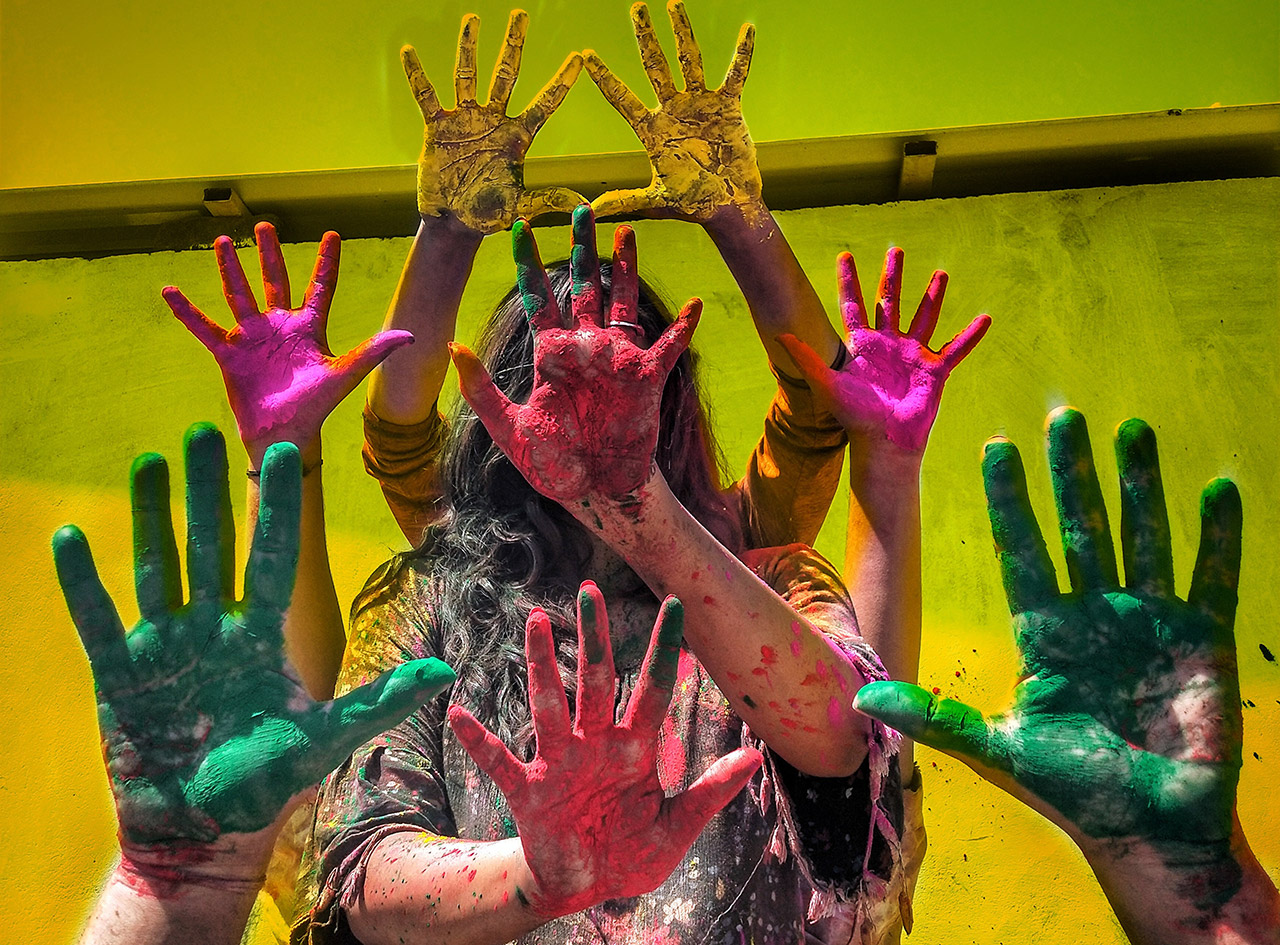
Indian culture is one of the most ancient cultures present in the world. The country is quite diverse and is home to several communities, each of whom has their own culture and traditions. It is this combination of various splendid cultures that make India one of a kind. The Indian cultural diversity is what makes India unique and beautiful.

Situated in the continent of Asia and enclosed by the Arabian sea, the Indian Ocean, and the Bay of Bengal, the nation, is divided into twenty-nine states and seven union territories. Pakistan, China, Bangladesh, Myanmar, Bhutan , and Nepal form the neighbouring countries of India.
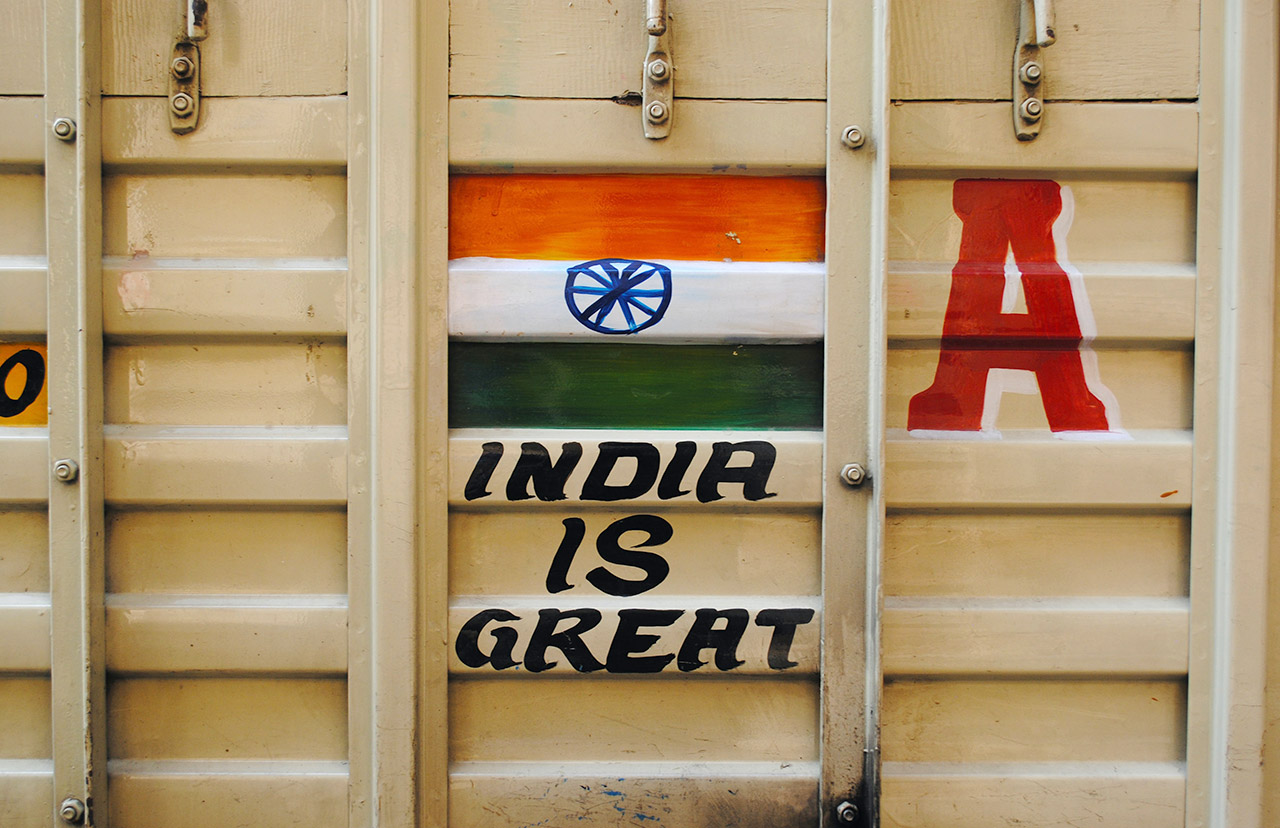
India is a land of diversity each state in the country is home to several communities who live in harmony with each other while preserving and upholding their own distinct culture and traditions. From Delhi , the capital of India, to Tamil Nadu , the southernmost state of India, the land, is blessed with amazing scenic beauty. The country is also home to several historical monuments which add to the varied heritage of India.
Recommended Read – Understanding the Culture of Indian States [Infographic]
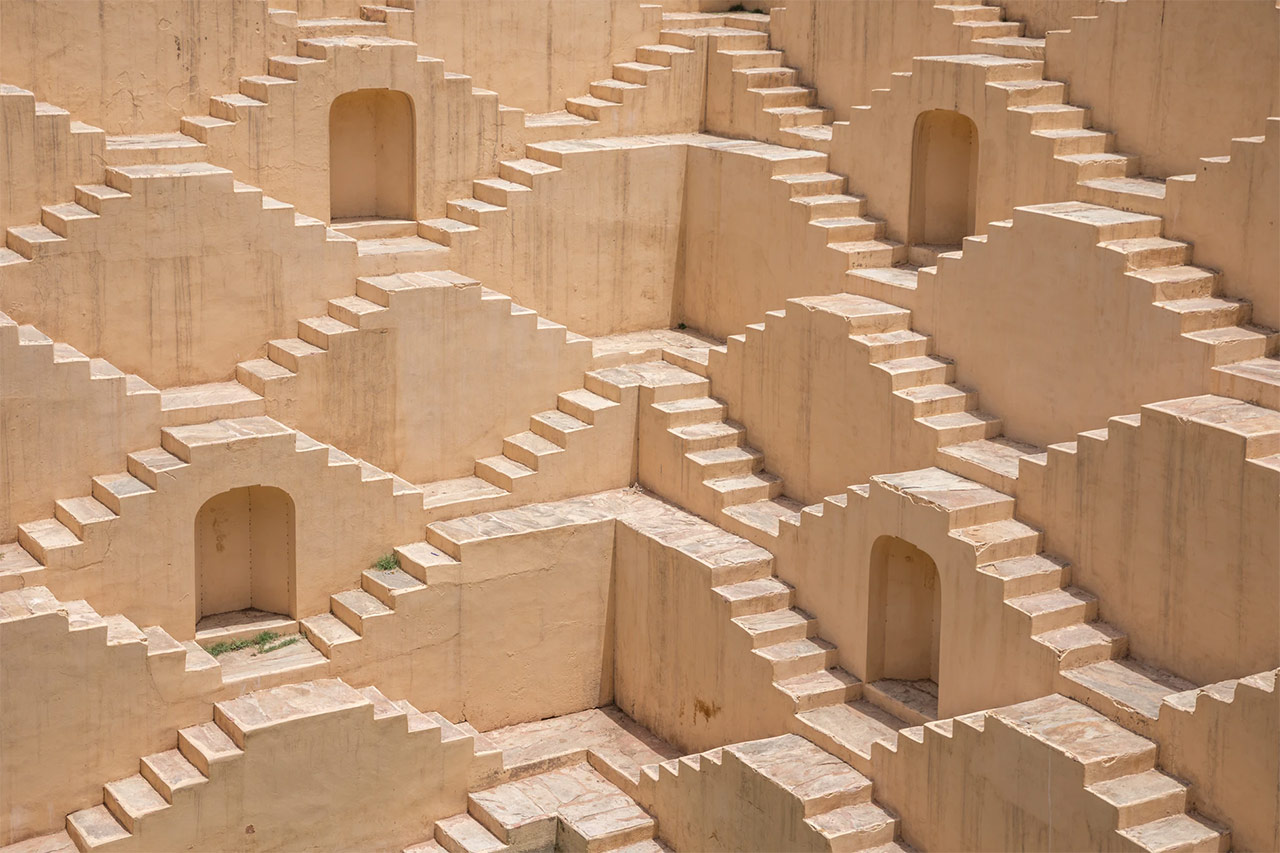
India is a country that is incredibly diversified and that of Indian architecture . India’s architecture spans from ancient caves to contemporary skyscrapers. As India grows, India’s architecture continues to diversify through continuously reverting to its roots while maintaining current trends.
India is also classified by the Dravidian and the Nagara architectural styles as the focal focus of Hindu architecture. In the empires, in the South of India, the Dravidian style prospered, whilst in the North of India, the Nagara style predominately appeared. India’s history, culture and religion are ingrained in its architecture.
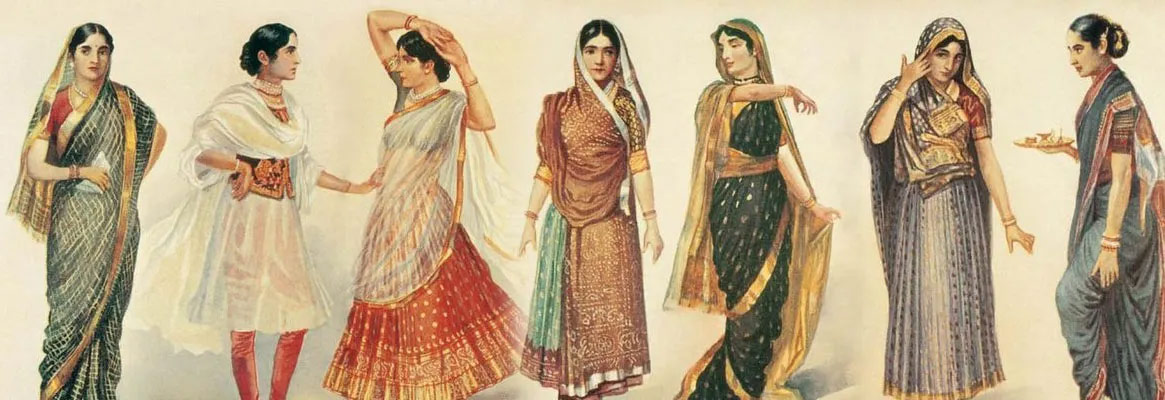
India’s vast and boundless array of traditional dress is full of aesthetic beauty. Made from many states of the country are fabrics, weaving processes, embellishments, styles and accessories of multiple sorts. A compelling epic about craftsmanship, culture or legacy tells a story in each piece. The land is a centre of heritage mode. Its diversity was a muse for a number of notable connoisseurs of fashion. In addition to the western clothing, Indians have their own ethnic attire like dhoti, kurta, sari, sherwani, turban etc. Dhoti is a piece of cloth draped around the waist by men. Dhoti is sometimes called Laacha or Dhuti. Kurta is one of India’s famous men’s ethnic clothing. It is usually worn on holidays today by folks. Likewise, the saree is the favourite choice for Indian women. A saree is a long robe, gracefully drawn by women around their bodies. Saree is Indian women’s most trendy clothing worldwide. Indian women are mostly seen in lovely sarees during religious and cultural events. However, due to their convenience, the sarees are substituted by salwar suits for the preferred daily wear.
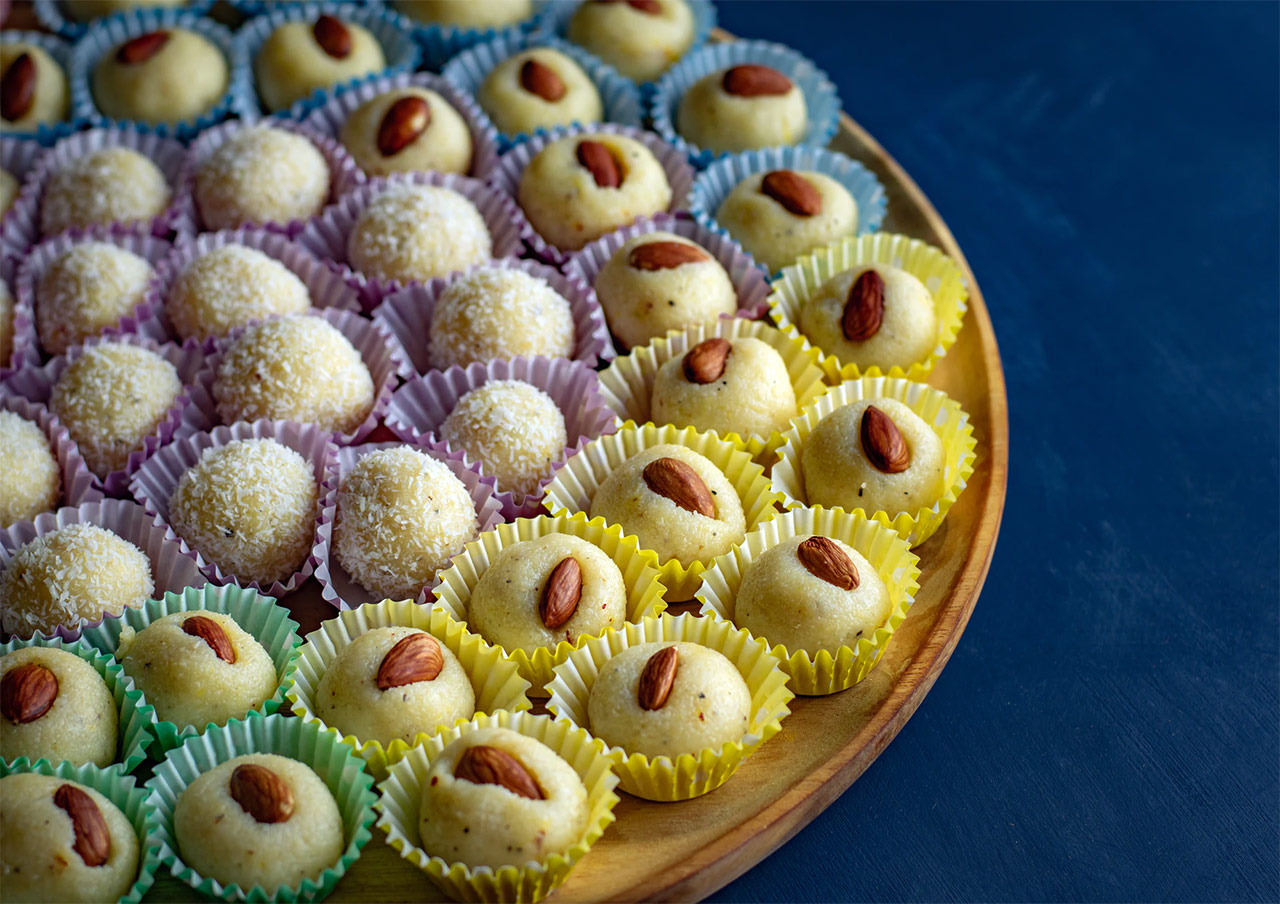
Indian food is one of the world’s most tasteful and nuanced. There is no flavour homogeneity between North and South or East and West but rather an incredible richness of tastes. One of India’s assets is its culinary diversity.
Indian food contains so much that one ought to discuss more than just “Indian cuisines.” Each region offers a number of traditional meals and its own culinary features.
Each area is specialised in cuisine, not solely at regional, but also at the provincial level. The diversity in cuisine stem from diverse local cultures, geography (whether the region is near the sea, desert or mountains), and the economy. Indigenous kitchen likewise relies heavily on fresh local products and is seasonal.
Indian cuisine tends generally to seek a balance between spices and herbs that offers delicious dishes with surprising therapeutic and medicinal benefits.
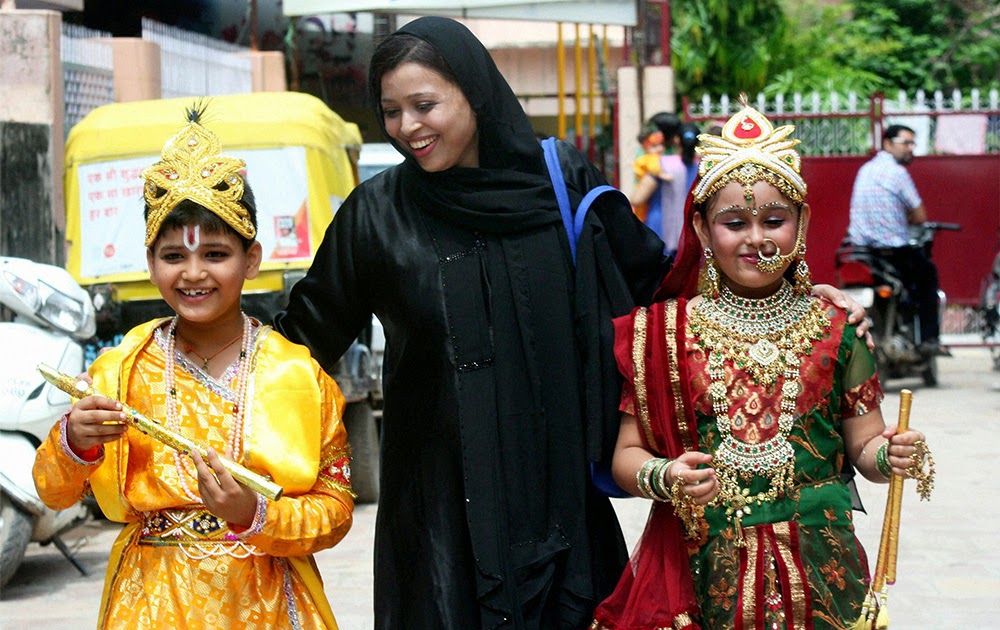
Indian religions have influenced and shaped the Indian culture
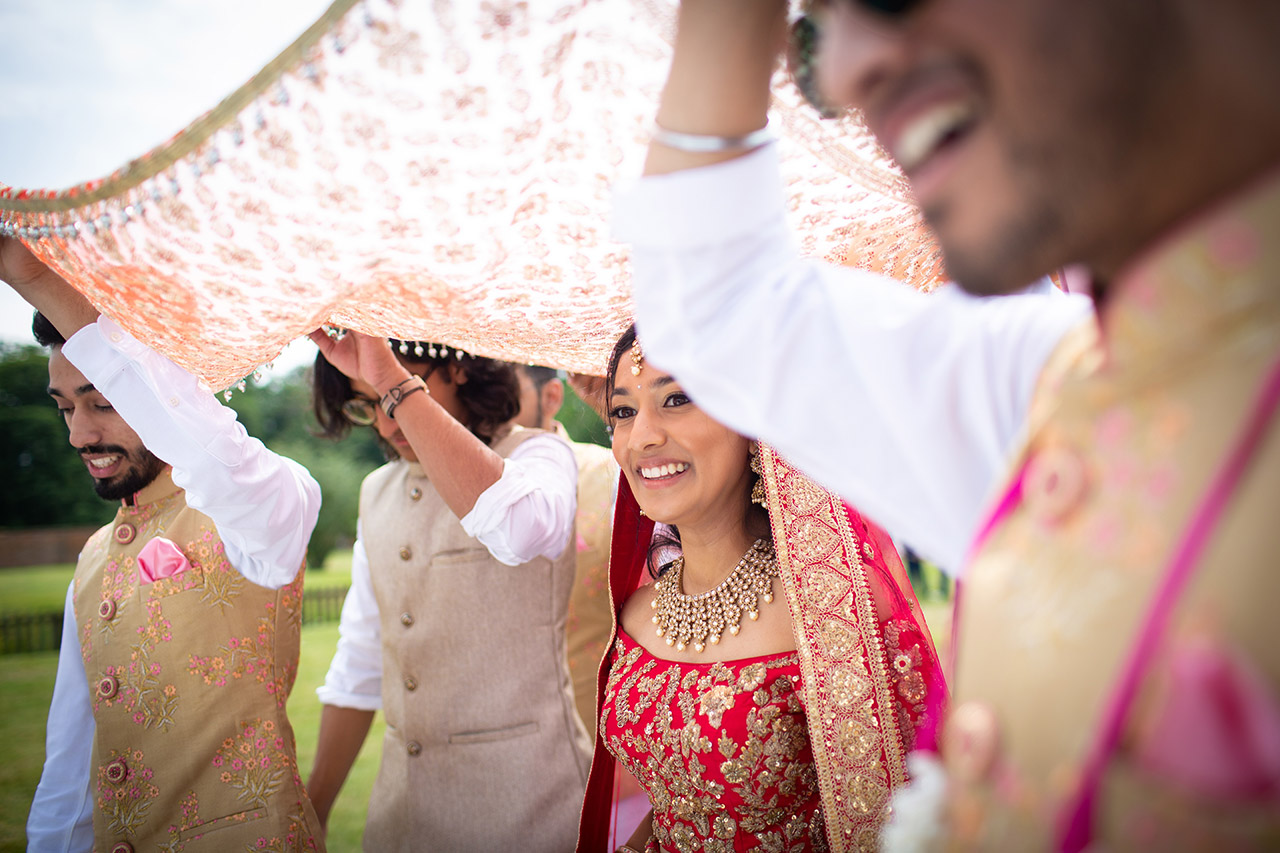
The vast differences in the customs, traditional beliefs and rituals can be witnessed if one analyses the differences in the culture prevalent in the northern and southern part of India. The festivals, the art forms, and to an extent, even the dressing style of the people are quite different in Northern India when compared to those in Southern India . While most of the Indian women wear the saree, the style of draping the saree varies in different parts of India. This difference can be seen, not only among different states but also among the various communities within the same state.
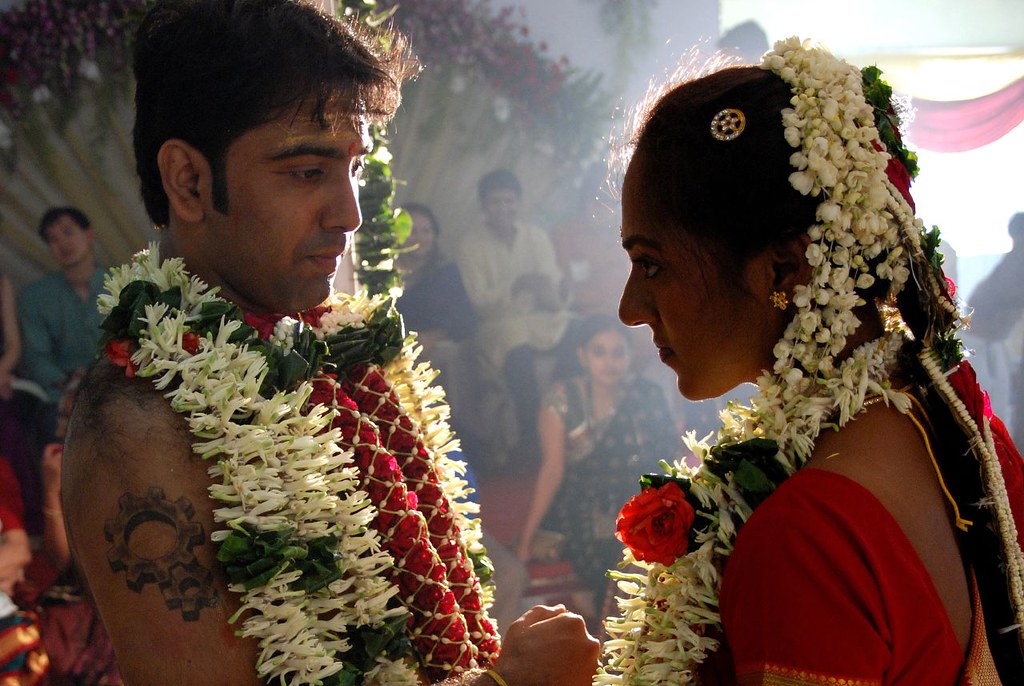
Though Hindi is the most commonly used language in India, there exist many other languages too. As diverse the country is, each state has its distinct language, such as Kannada, (which, is spoken in Karnataka), Malayalam, (which, is spoken in Kerala), Tamil , is spoken in Tamil Nadu, etc. Apart from the fact that each state has its own language, it is also worth mentioning that some states in India have more than one and sometimes more than three prevalent languages. Due to this, it would not come as a surprise that most Indians are bilingual (or sometimes Multilingual), and can effortlessly handle more than one or two languages.
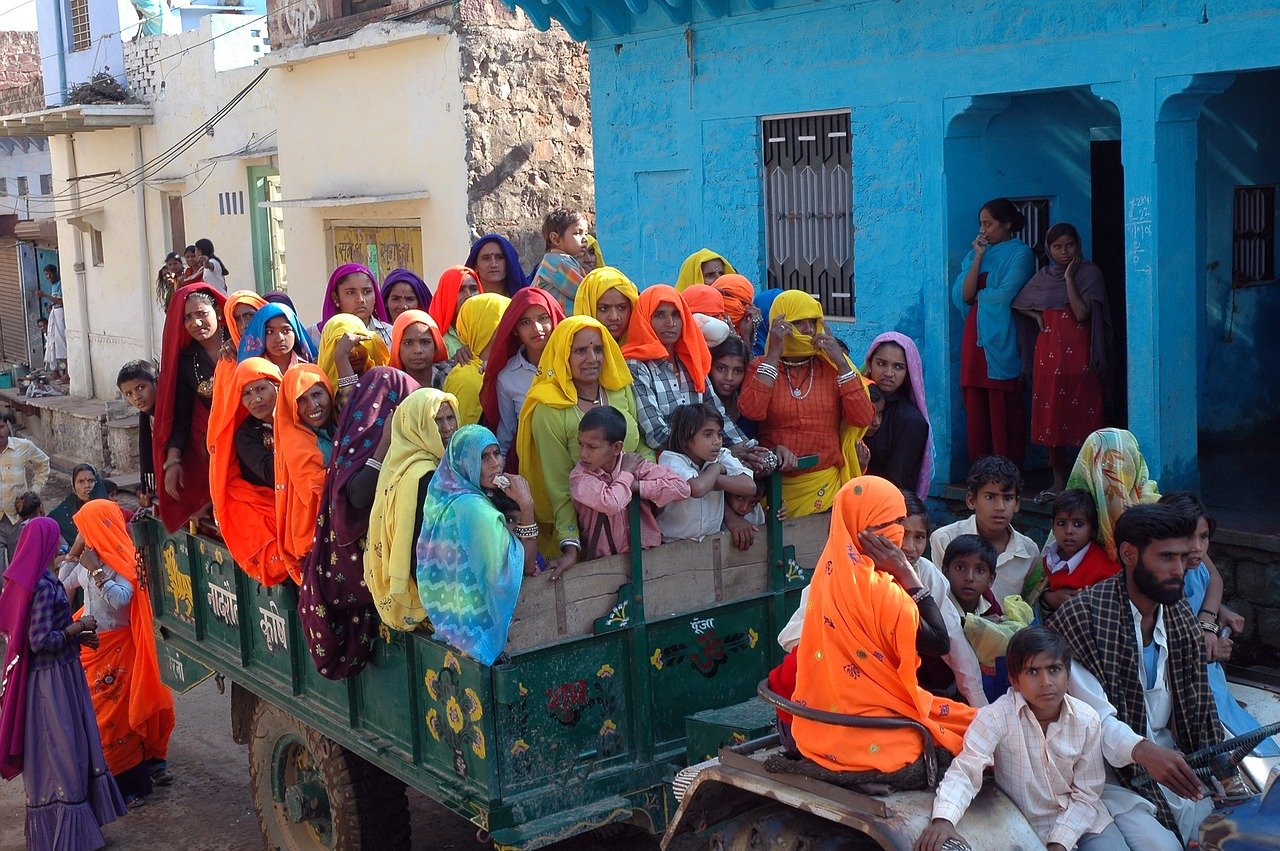
The family has always been an integral part of Indian society. In an Indian family, all the members share a close-knit connection. Joint families are also common in the country. In joint families, all the members of the family live under the same roof. However, in present times, nuclear families are becoming more common. In India, arranged marriages are relatively more common. The concept of an arranged marriage might seem a bit confusing to people from the western part of the world. However, in India, arranged marriages are more encouraged and are still very much prevalent in the country.
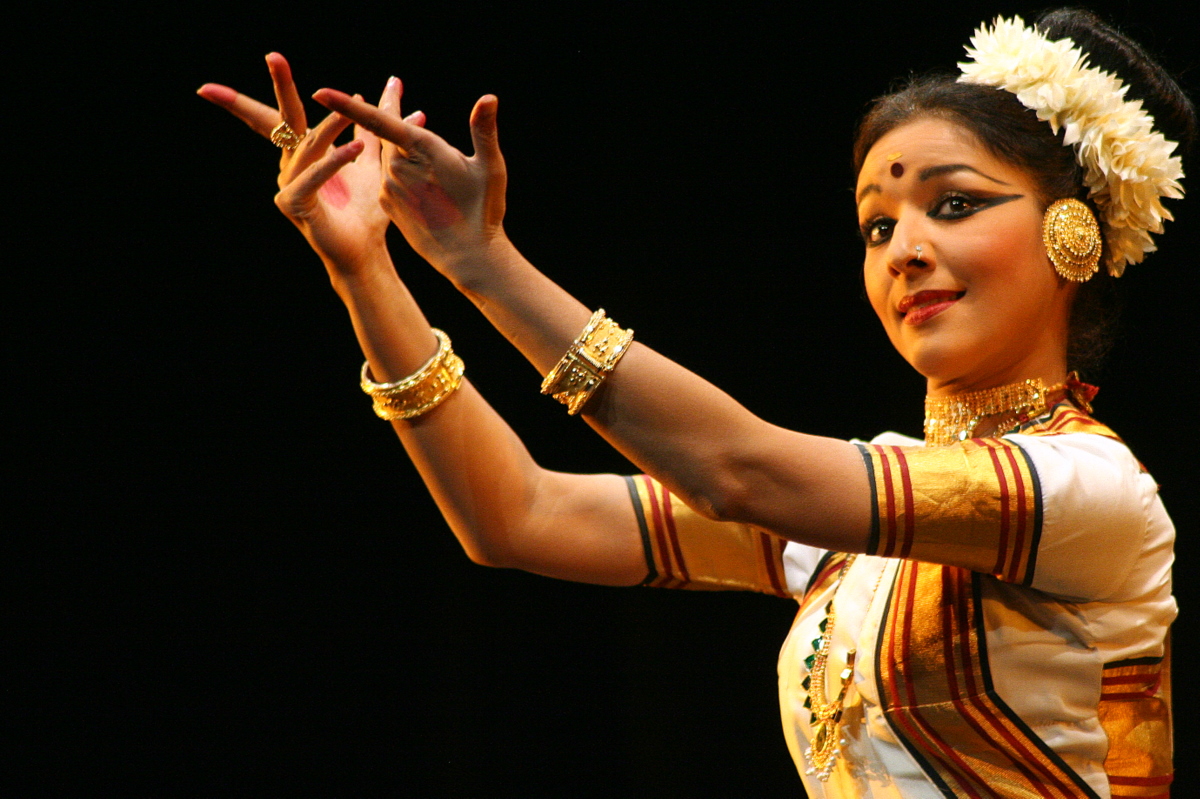
The unique and splendid art forms of India have a significant position in the culture of India. Each state is blessed with its unique art form and differs considerably from that of its neighbour. Though, it is worthwhile to note that many art forms of India are in some ways the amalgamation of other art forms borrowed from the neighbouring states. From the elegant Mohiniyattam , which focuses on the elegant and graceful movements of the dancer to the Ghoomar , a folk dance in Rajasthan, the art forms vary from each other but are equally beautiful and magical.
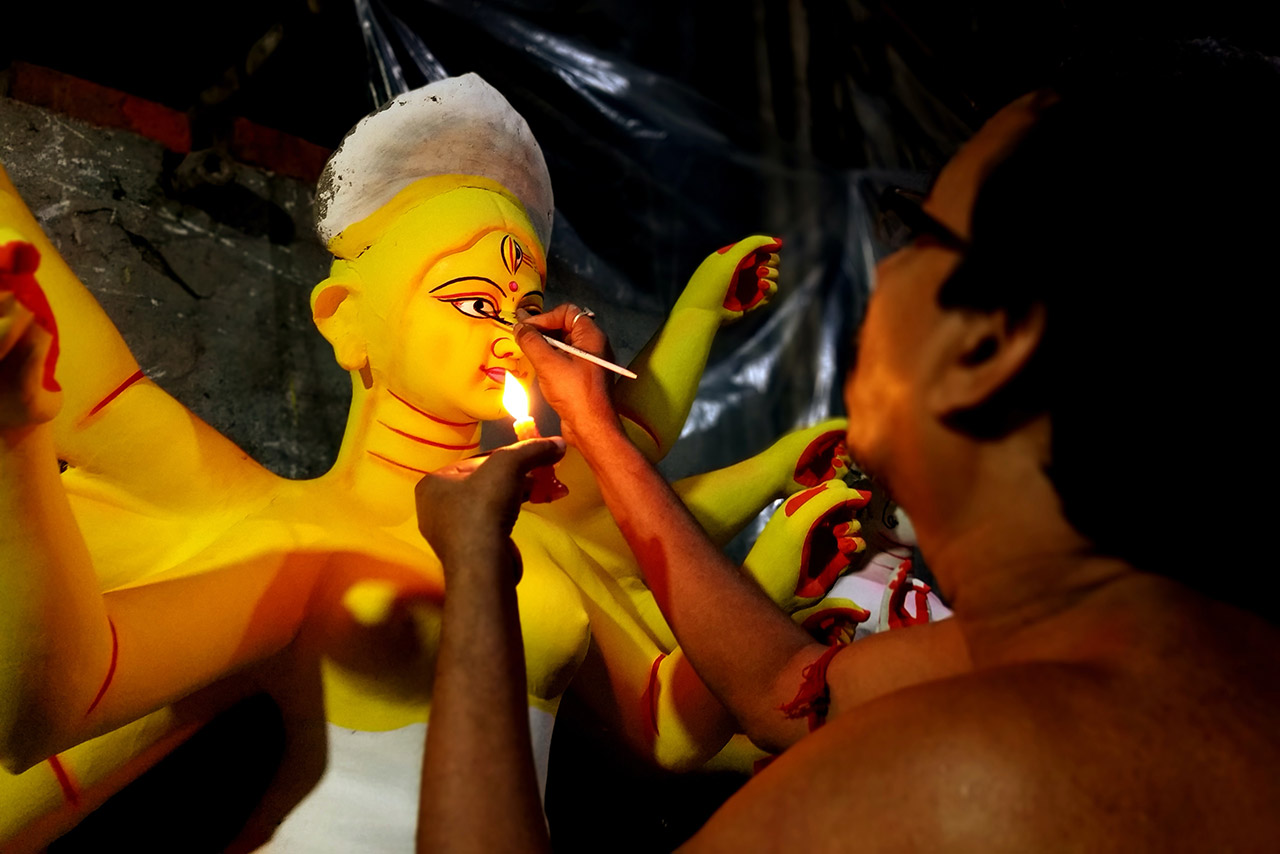
The festivals of India , too, are worth mentioning. As said earlier, each state has its own festivals, from the fragrant Onam, the festival of Kerala , which is characterized by the making of a floral carpet to the Pôhela Boishakh, (the onset New Year according to the Bengali calendar), the festivals are both colourful and equally incredible.
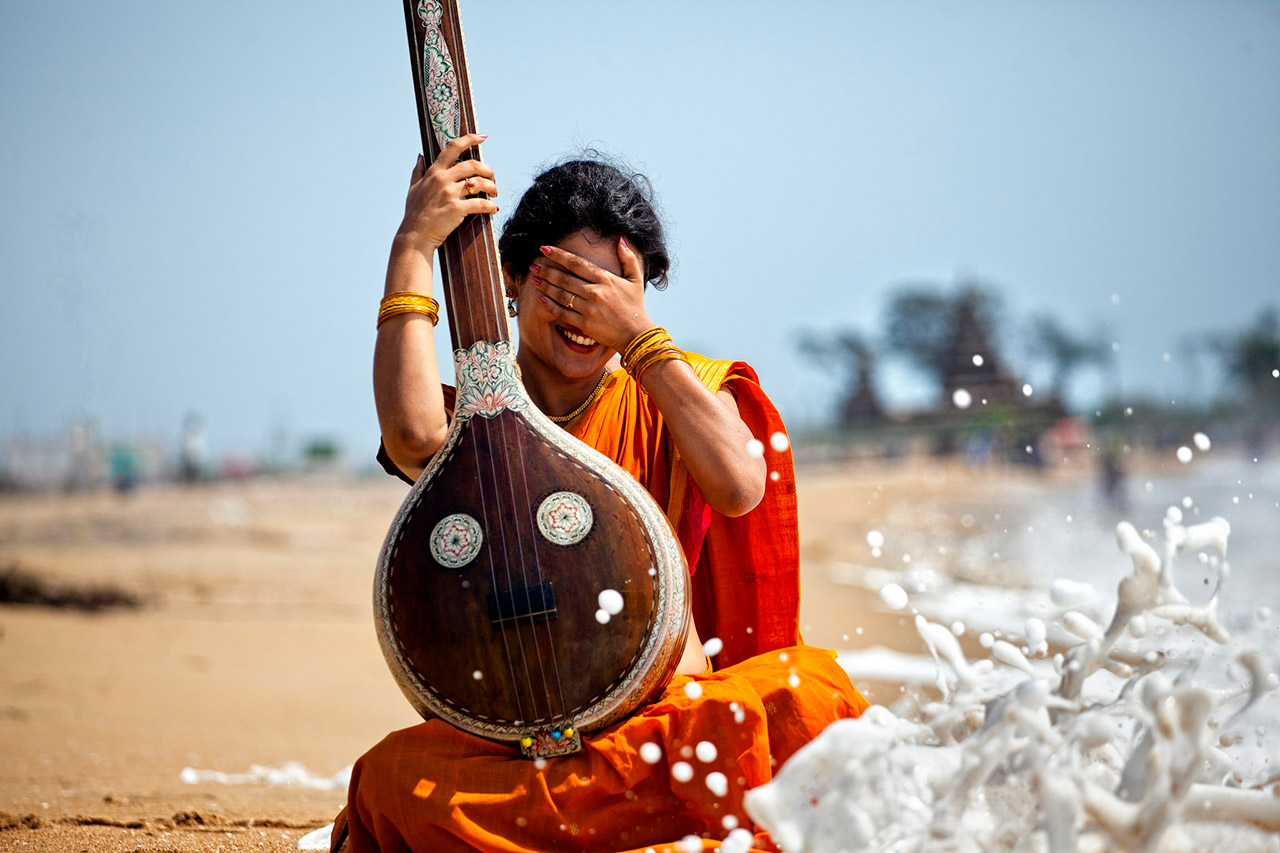
Music plays a significant role in the culture of any country, and India, too, is not an exception. Carnatic music , Hindustani music are the most popular in India. These are usually accompanied by the tune of the traditional musical instruments such as the tabla and the veena. Indian music is quite soothing and pleasing to the ear.
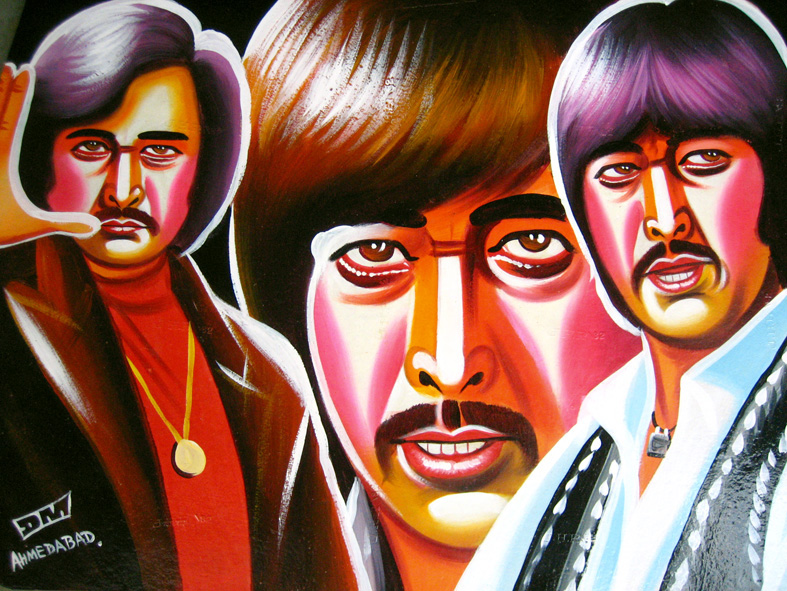
The movies produced in India, too, reflect the culture of the society. Each state in India has its own movie industry, though Bollywood is the most popular among them. The movie industries in India are known by different terms such as Mollywood (Malayalam movie industry), Tollywood, etc. Owing to the number of movies produced each year in different languages across India, adding to the fact that Indians love movies, India has now become one of the greatest producers of films.
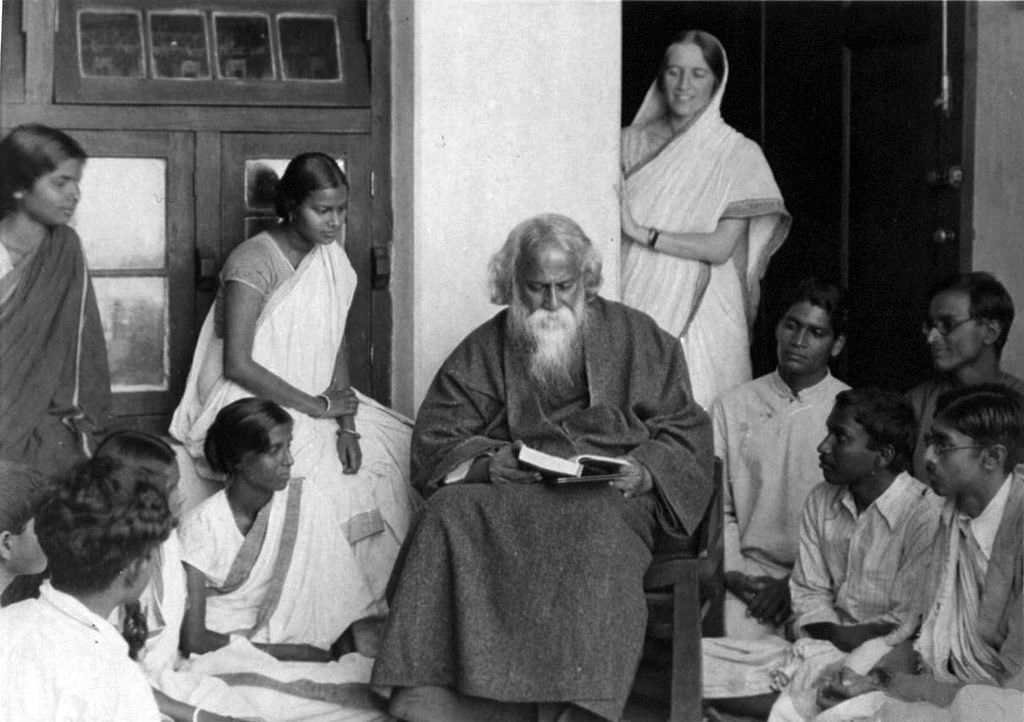
India has also been blessed with many intellectuals and legendary writers and poets who are renowned worldwide for their contributions to humanity. Prominent among them is Rabindranath Tagore , the first Asian and Indian to win the Nobel Prize . His work Gitanjali continues to spread its message and inspires all those who read it. Other prominent writers of India include Sarojini Naidu, Aurobindo Ghosh, among others. Artists such as Raja Ravi Varma, Rabindranath Tagore, and M F Hussain have helped in changing the face of Indian art.
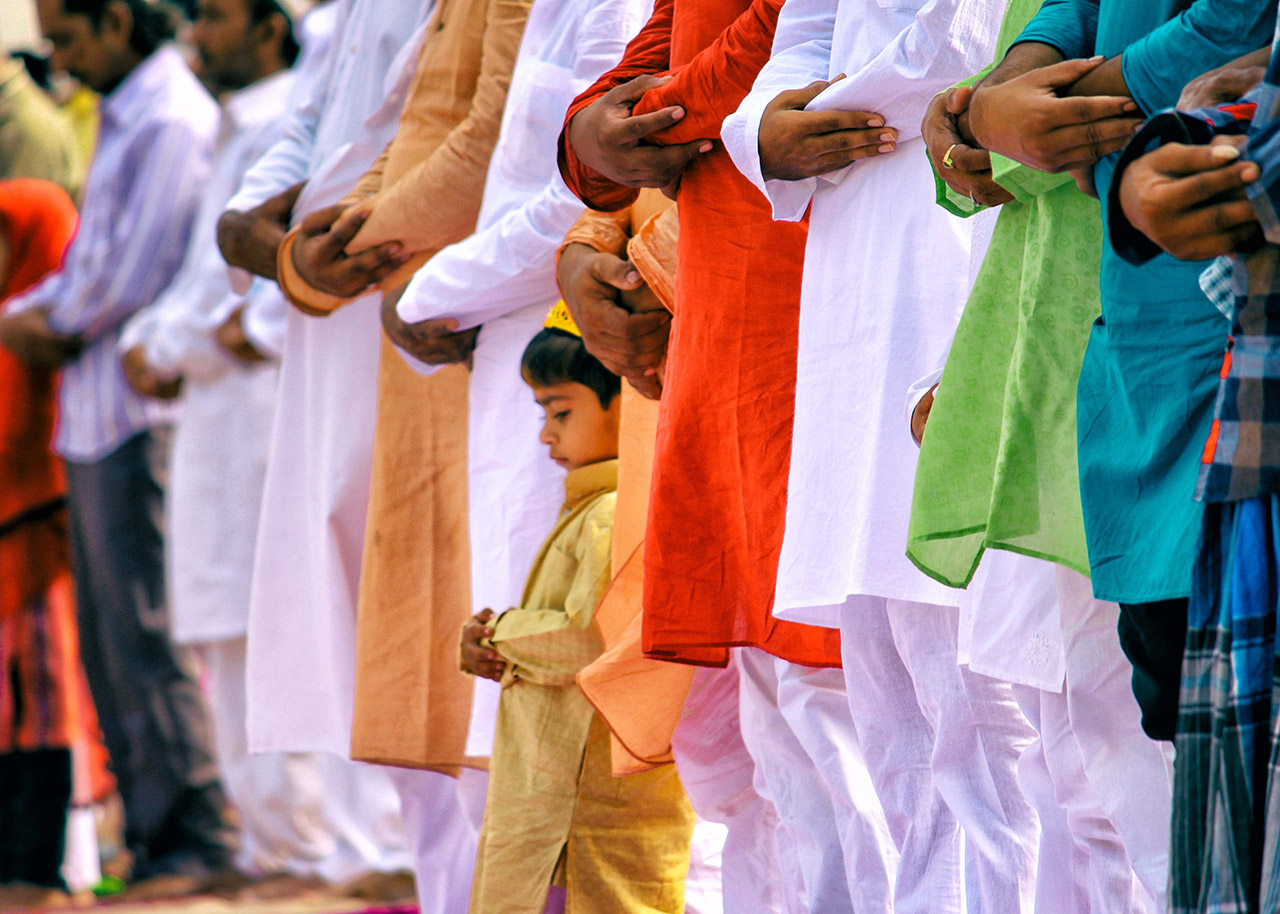
Festivals and celebrations are a common occurrence in India as they occur almost every other day; however, the grandeur and pomp of these festivals are quite impressive. The country is also home to many heritage sites and monuments , including the Taj Mahal. It is all these facts combined that makes the Indian culture unique and distinct from others.

The seventh-largest country in the world, India has set itself a unique and distinct place among the other countries of the world. The host of a culture that has been prevalent for a long time, India is perhaps one of the most diverse countries in the world. From the attire worn by the people belonging to different communities to the languages spoken and even in the food habits, the country both reflects its diversity and varied heritage.
Cover Photo by Tom Chen on Unsplash
Image credits: The copyright for the images used in this article belong to their respective owners. Best known credits are given under the image. For changing the image credit or to get the image removed from Caleidoscope, please contact us.
very good knowledge
Very good guys
It’s very helpful for my science homework theme page: celebrating cultural diversity
Thanks Aarradhya, all the best for your class project!
LEAVE A REPLY Cancel reply
Save my name, email, and website in this browser for the next time I comment.
INSPIRING READS
Old love vs modern love, world radio day: celebrating india’s legacy from akashvani to podcasts, 5 trendsetting mangalsutra designs for the contemporary bride, shankaracharya – the saint who revived hinduism, the most valuable things that british took from india, southern splendour – glimpses of ten iconic temples of south india, trending topics.
- Terms of Use
- Privacy Policy
Affiliate disclosure: As an Amazon Associate, we may earn commissions from qualifying purchases from Amazon. Learn more
© caleidoscope - 2024.
- Skip to primary navigation
- Skip to main content
- Skip to primary sidebar
UPSC Coaching, Study Materials, and Mock Exams
Enroll in ClearIAS UPSC Coaching Join Now Log In
Call us: +91-9605741000
Diversity of India
Last updated on April 4, 2024 by ClearIAS Team

Despite numerous foreign invasions, a vast synthesis of the cultures, faiths, and languages of the people from all castes and communities has maintained its cohesion and unity.
Even if stark economic and social disparities have prevented the formation of egalitarian social relations, national unity and integrity have been preserved. This fusion has transformed India into a singular mosque of cultures. India thus presents a situation that appears to be multicultural within the context of a single, cohesive cultural whole.
Also read: Minorities in India
Table of Contents
What does diversity mean?
The word “diversity” places more emphasis on differences than on unfairness. It refers to group disparities, or distinctions separating one group of individuals from another. These differences could be biological, religious, linguistic, or anything else. Diversity refers to the variety of races, religions, languages, castes, and cultures.
Integrity refers to unity. It is a state of social psychology. It suggests a sense of unity and togetherness. It represents the ties that keep a society’s members together. Essentially, “unity in diversity” means “diversity without fragmentation” and “unity without uniformity.” It is predicated on the idea that diversity enhances interpersonal communication.
When we refer to India as a country with rich cultural diversity, we are referring to the wide variety of social groupings and cultures that call India home. These groups identify primarily through cultural traits like language, religion, sect, race, or caste.
Learn more from: ClearIAS Study Materials
Also read: Environmental Racism
Forms of India’s Diversity
The different forms of India’s diversity include the following.
Religious diversity
India is a country that is home to many different religions. The Indian population is made up of Hindus (82.41%), Muslims (11.6%), Christians (2.32%), Sikhs (1.99%), Buddhists (0.77%), and Jains (0.41%), in addition to the tribal societies, many of which continue to practice animism and magic.
Hindus are divided into several sects, including Vaishnavas, Shaivites, Shaktas, and Smartas. Similarly, there are various Muslim sects, including Shi’ites, Sunnis, Ahmadis, etc.
Language diversity
The major language families among the languages spoken in India are the Dravidian languages, which are spoken by 20% of Indians, and the Indo-Aryan languages, which are spoken by 75% of Indians.
The Austroasiatic, Sino-Tibetan, Tai-Kadai, and a few other minor language families and isolates are home to other languages.
After Papua New Guinea, India has the second-highest number of languages in the world. India’s ethnic variety was divided into the following groups according to the 1931 census: Negrito, Proto-Australoid, Mongoloid, Mediterranean, Western Brachycephals, and Nordic.
Also Read: Endangered Languages of India
The Caste Diversity
The Caste Diversity includes members of all three major world races, namely Caucasoid, Mongoloid, and Negroid: India is a nation with Both varna and jati have been referred to as “caste” in the past. According to functional differentiation, society is divided into four groups called Varna. Brahmins, Kshatriyas, Vaishyas, Shudras, and an outcaste.
While the term “Jati” designates a hereditary endogamous status group engaged in a certain traditional profession. There are more than 3000 jatis, and there isn’t a single system for classifying and ranking them across all of India. The jati system is dynamic and allows for movement, which has allowed jatis to vary their location throughout time. M. N. Srinivas referred to this method of upward mobility as “Sanskritization.”
Ethnic diversity
Ethnic diversity Regional differences are reflected in cultural patterns. Due to demographic diversity, Indian culture is extremely diverse and is a fusion of many other cultures. Every region, caste, and religion has its unique traditions and culture. As a result, there are variations in music, dance, theatre, and architecture.
Geographic diversity
With a total land area of 3.28 million square kilometers, India is a big nation with a wide variety of natural landscapes , including deserts, evergreen forests, steep mountains, perennial and non-perennial river systems, lengthy coasts, and fertile plains.
In addition to the major forms of variety already mentioned, India also has diversity in many other areas, such as tribal, rural, and urban patterns of habitation, patterns of marriage and kinship along religious and regional lines, and more.
Also read: Salient features of Indian Society – ClearIAS
Factors Promoting Unity in India’s Diversity
- Constitutional identity : A single person is elected to lead the entire nation. Even Nevertheless, the majority of states adhere to a standard 3-tier structure of government, bringing
- Furthermore, regardless of their age, gender, class, caste, or religion, all citizens are guaranteed certain fundamental rights under the Constitution.
- Religion tolerance is the distinctive characteristic of faiths in India, and as a result, many different religions coexist there. The Constitution itself guarantees the freedom of religion and practice. Additionally, the state accords equal preference to all religions and has no official state religion.
- Interstate movement : Article 19 (1) (d) of the Constitution ensures freedom of movement throughout India’s territory, fostering a sense of brotherhood and solidarity among the people.
- Other elements that contribute to consistency in the criminal justice system and policy implementation include the uniformity of the law, penal code, and administrative tasks (such as All India Services).
- Economic integration : The Goods and Service Tax (GST) has paved the way for “one country, one tax, one national market,” thereby facilitating unity among different regions. The Indian Constitution also guarantees the freedom of trade, commerce, and intercourse within the territory of India under Article.
- Institution of pilgrimage and religious practices: Spirituality and religion are very important in India. Religious sites and sacred rivers can be found all over the length and breadth of the country, from Badrinath and Kedarnath in the north to Rameshwaram in the south, Jagannath Puri in the east, and Dwaraka in the west. They are closely tied to the long-standing tradition of pilgrimage, which has always drawn people to different regions of the nation and given them a feeling of geo-cultural identity.
- Fairs and festivals : These serve as integrating factors as well because people from all across the nation participate in them. Hindus around the nation celebrate Diwali, just as Muslims and Christians celebrate Id and Christmas, respectively. In India, interreligious celebrations are also observed.
- Weather integration via the monsoon : The monsoon season affects the entire Indian subcontinent’s flora and fauna, agricultural activities, and way of life, including holidays. Sports and cinema are widely popular throughout the nation, serving as unifying forces. Factors that undermine India’s unity include:
- Regionalism : Regionalism favors the interests of a certain region or region over those of the nation. It may also hurt national integration. Regional demands and the resulting law and order situation
- Polarising politics : Politicians would occasionally invoke ascriptive identities like caste, religion, etc. to gain support. Violence, feelings of mistrust, and suspicion among minorities can emerge from this kind of polarising politics.
- Unbalanced development Backwardness of a region can be brought on by uneven socioeconomic growth, poor economic policies, and the resulting economic inequities. As a result, this may spark acts of violence, ignite migrant waves, or even fuel separatist demands. For instance, numerous examples of secessionist demands and tendencies have emerged as a result of the North East’s economic underdevelopment.
- Ethnic diversity and nativism: Ethnic diversity has frequently resulted in conflicts between various ethnic groups, particularly as a result of reasons like employment competition, a lack of resources, and threats to identity For instance, Bodos and Muslims who speak Bengali frequently fight in Assam. The son of the soil idea, which links people to their place of birth and bestows upon them certain advantages, privileges, duties, and obligations that may not apply to others, has served to emphasize this.
- Geographic isolation: Isolation can also result in separatist thinking and identity problems. Geographically, the North-East is separated from the rest of the nation by a small passageway called the Siliguri corridor, sometimes known as the “Chicken’s Neck.”The area is less developed economically than the rest of the nation and has poor infrastructure. As a result, it has seen several incidents of separatist and cross-border terrorism.
- Inter-religious disputes : Inter-religious disputes not only deteriorate relations between two communities by sowing distrust and fear, but they also damage the nation’s secular fabric.
- Conflicts between states : This may cause feelings of regionalism to grow. Additionally, it may have an impact on interstate commerce and communication. For instance, the Karnataka-Tamil Cauvery River dispute
- External influences : External influences, such as foreign organizations, terrorist organizations, and extremist groups, can occasionally inspire violence and foster feelings of secession. g. Inter-Services Intelligence (ISI) is alleged to have supported and trained mujahideen to fight in Jammu and Kashmir and incite separatist sentiment among local groupings.
Despite the difficulties diversity might provide, there is no denying the vital role sociocultural diversity has played in maintaining and advancing Indian culture.
The handling of diversity in Indian society, not diversity itself, is the issue. Because the benefits of growth haven’t been divided fairly or certain groups’ cultures haven’t received the acknowledgment they deserve, problems like regionalism, communalism, and ethnic conflicts have emerged.
Therefore, the Constitution and its ideas must serve as the foundation of our society. Any culture that has attempted to homogenize itself has experienced eventual stagnation and decline. The most notable instance in this situation is Pakistan’s attempt to force its culture on East Pakistan, ultimately leading to Bangladesh’s establishment.
Article Written By: Atheena Fathima Riyas

Take a Test: Analyse Your Progress
Aim IAS, IPS, or IFS?

About ClearIAS Team
ClearIAS is one of the most trusted learning platforms in India for UPSC preparation. Around 1 million aspirants learn from the ClearIAS every month.
Our courses and training methods are different from traditional coaching. We give special emphasis on smart work and personal mentorship. Many UPSC toppers thank ClearIAS for our role in their success.
Download the ClearIAS mobile apps now to supplement your self-study efforts with ClearIAS smart-study training.
Reader Interactions
Leave a reply cancel reply.
Your email address will not be published. Required fields are marked *
Don’t lose out without playing the right game!
Follow the ClearIAS Prelims cum Mains (PCM) Integrated Approach.
Join ClearIAS PCM Course Now
UPSC Online Preparation
- Union Public Service Commission (UPSC)
- Indian Administrative Service (IAS)
- Indian Police Service (IPS)
- IAS Exam Eligibility
- UPSC Free Study Materials
- UPSC Exam Guidance
- UPSC Prelims Test Series
- UPSC Syllabus
- UPSC Online
- UPSC Prelims
- UPSC Interview
- UPSC Toppers
- UPSC Previous Year Qns
- UPSC Age Calculator
- UPSC Calendar 2024
- About ClearIAS
- ClearIAS Programs
- ClearIAS Fee Structure
- IAS Coaching
- UPSC Coaching
- UPSC Online Coaching
- ClearIAS Blog
- Important Updates
- Announcements
- Book Review
- ClearIAS App
- Work with us
- Advertise with us
- Privacy Policy
- Terms and Conditions
- Talk to Your Mentor
Featured on

and many more...

Unity in Diversity: The Essence of India’s Composite Culture | Essay Writing for UPSC by Vikash Ranjan Sir | Triumph ias
Table of Contents
India’s Mosaic: A Celebration of Unity in Diversity
(relevant for essay writing for upsc civil services examination).
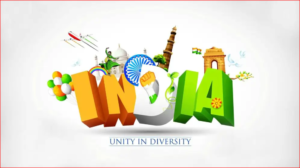
India’s vibrant landscape is dotted with myriad cultures, traditions, and histories. Dive into the mesmerizing mosaic of India’s composite culture and discover how it epitomizes unity in diversity.
The Threads of Time
From the ancient Indus Valley Civilization to modern-day India, the country has imbibed, evolved, and celebrated a myriad of influences, giving birth to its unique identity.
A Symphony of Cultures
Whether it’s the resonating chants from temples, the melodic calls for prayer from mosques, or the harmonious carols from churches, India embraces them all with open arms. Languages, festivals, art – every facet of Indian life reflects its harmonious blend.
Conclusion: A Lesson for the World
In times of global divisiveness, India’s composite culture stands tall as a testament to the strength and beauty of unity in diversity.
To master these intricacies and fare well in the Sociology Optional Syllabus , aspiring sociologists might benefit from guidance by the Best Sociology Optional Teacher and participation in the Best Sociology Optional Coaching . These avenues provide comprehensive assistance, ensuring a solid understanding of sociology’s diverse methodologies and techniques
India, Composite Culture, Unity in Diversity, Religions, Languages, Festivals, Art, Architecture, Historical Evolution.

Sociology Optional Syllabus Course Commencement Information
- Enrolment is limited to a maximum of 250 Seats.
- Course Timings: Evening Batch
- Course Duration: 4.5 Months
- Class Schedule: Monday to Saturday
- Batch Starts from: Admission open for online batch
Book Your Seat Fast Book Your Seat Fast
We would like to hear from you. Please send us a message by filling out the form below and we will get back with you shortly.
Instructional Format:
- Each class session is scheduled for a duration of two hours.
- At the conclusion of each lecture, an assignment will be distributed by Vikash Ranjan Sir for Paper-I & Paper-II coverage.
Study Material:
- A set of printed booklets will be provided for each topic. These materials are succinct, thoroughly updated, and tailored for examination preparation.
- A compilation of previous years’ question papers (spanning the last 27 years) will be supplied for answer writing practice.
- Access to PDF versions of toppers’ answer booklets will be available on our website.
- Post-course, you will receive two practice workbooks containing a total of 10 sets of mock test papers based on the UPSC format for self-assessment.
Additional Provisions:
- In the event of missed classes, video lectures will be temporarily available on the online portal for reference.
- Daily one-on-one doubt resolution sessions with Vikash Ranjan Sir will be organized post-class.
Syllabus of Sociology Optional
FUNDAMENTALS OF SOCIOLOGY
- Modernity and social changes in Europe and emergence of sociology.
- Scope of the subject and comparison with other social sciences.
- Sociology and common sense.
- Science, scientific method and critique.
- Major theoretical strands of research methodology.
- Positivism and its critique.
- Fact value and objectivity.
- Non- positivist methodologies.
- Qualitative and quantitative methods.
- Techniques of data collection.
- Variables, sampling, hypothesis, reliability and validity.
- Karl Marx- Historical materialism, mode of production, alienation, class struggle.
- Emile Durkheim- Division of labour, social fact, suicide, religion and society.
- Max Weber- Social action, ideal types, authority, bureaucracy, protestant ethic and the spirit of capitalism.
- Talcott Parsons- Social system, pattern variables.
- Robert K. Merton- Latent and manifest functions, conformity and deviance, reference groups.
- Mead – Self and identity.
- Concepts- equality, inequality, hierarchy, exclusion, poverty and deprivation.
- Theories of social stratification- Structural functionalist theory, Marxist theory, Weberian theory.
- Dimensions – Social stratification of class, status groups, gender, ethnicity and race.
- Social mobility- open and closed systems, types of mobility, sources and causes of mobility.
- Social organization of work in different types of society- slave society, feudal society, industrial /capitalist society
- Formal and informal organization of work.
- Labour and society.
- Sociological theories of power.
- Power elite, bureaucracy, pressure groups, and political parties.
- Nation, state, citizenship, democracy, civil society, ideology.
- Protest, agitation, social movements, collective action, revolution.
- Sociological theories of religion.
- Types of religious practices: animism, monism, pluralism, sects, cults.
- Religion in modern society: religion and science, secularization, religious revivalism, fundamentalism.
- Family, household, marriage.
- Types and forms of family.
- Lineage and descent.
- Patriarchy and sexual division of labour.
- Contemporary trends.
- Sociological theories of social change.
- Development and dependency.
- Agents of social change.
- Education and social change.
- Science, technology and social change.
INDIAN SOCIETY: STRUCTURE AND CHANGE
Introducing indian society.
- Indology (GS. Ghurye).
- Structural functionalism (M N Srinivas).
- Marxist sociology (A R Desai).
- Social background of Indian nationalism.
- Modernization of Indian tradition.
- Protests and movements during the colonial period.
- Social reforms.
SOCIAL STRUCTURE
- The idea of Indian village and village studies.
- Agrarian social structure – evolution of land tenure system, land reforms.
- Perspectives on the study of caste systems: GS Ghurye, M N Srinivas, Louis Dumont, Andre Beteille.
- Features of caste system.
- Untouchability – forms and perspectives.
- Definitional problems.
- Geographical spread.
- Colonial policies and tribes.
- Issues of integration and autonomy.
- Social Classes in India:
- Agrarian class structure.
- Industrial class structure.
- Middle classes in India.
- Lineage and descent in India.
- Types of kinship systems.
- Family and marriage in India.
- Household dimensions of the family.
- Patriarchy, entitlements and sexual division of labour
- Religious communities in India.
- Problems of religious minorities.
SOCIAL CHANGES IN INDIA
- Idea of development planning and mixed economy
- Constitution, law and social change.
- Programmes of rural development, Community Development Programme, cooperatives,poverty alleviation schemes
- Green revolution and social change.
- Changing modes of production in Indian agriculture.
- Problems of rural labour, bondage, migration.
3. Industrialization and Urbanisation in India:
- Evolution of modern industry in India.
- Growth of urban settlements in India.
- Working class: structure, growth, class mobilization.
- Informal sector, child labour
- Slums and deprivation in urban areas.
4. Politics and Society:
- Nation, democracy and citizenship.
- Political parties, pressure groups , social and political elite
- Regionalism and decentralization of power.
- Secularization
5. Social Movements in Modern India:
- Peasants and farmers movements.
- Women’s movement.
- Backward classes & Dalit movement.
- Environmental movements.
- Ethnicity and Identity movements.
6. Population Dynamics:
- Population size, growth, composition and distribution
- Components of population growth: birth, death, migration.
- Population policy and family planning.
- Emerging issues: ageing, sex ratios, child and infant mortality, reproductive health.
7. Challenges of Social Transformation:
- Crisis of development: displacement, environmental problems and sustainability
- Poverty, deprivation and inequalities.
- Violence against women.
- Caste conflicts.
- Ethnic conflicts, communalism, religious revivalism.
- Illiteracy and disparities in education.
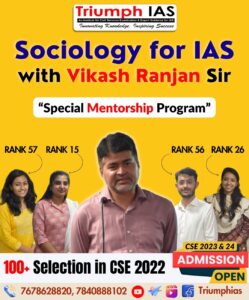
Mr. Vikash Ranjan, arguably the Best Sociology Optional Teacher , has emerged as a versatile genius in teaching and writing books on Sociology & General Studies. His approach to the Sociology Optional Syllabus / Sociology Syllabus is remarkable, and his Sociological Themes and Perspectives are excellent. His teaching aptitude is Simple, Easy and Exam Focused. He is often chosen as the Best Sociology Teacher for Sociology Optional UPSC aspirants.
About Triumph IAS
Innovating Knowledge, Inspiring Success We, at Triumph IAS , pride ourselves on being the best sociology optional coaching platform. We believe that each Individual Aspirant is unique and requires Individual Guidance and Care, hence the need for the Best Sociology Teacher . We prepare students keeping in mind his or her strength and weakness, paying particular attention to the Sociology Optional Syllabus / Sociology Syllabus , which forms a significant part of our Sociology Foundation Course .
Course Features
Every day, the Best Sociology Optional Teacher spends 2 hours with the students, covering each aspect of the Sociology Optional Syllabus / Sociology Syllabus and the Sociology Course . Students are given assignments related to the Topic based on Previous Year Question to ensure they’re ready for the Sociology Optional UPSC examination.
Regular one-on-one interaction & individual counseling for stress management and refinement of strategy for Exam by Vikash Ranjan Sir , the Best Sociology Teacher , is part of the package. We specialize in sociology optional coaching and are hence fully equipped to guide you to your dream space in the civil service final list.
Specialist Guidance of Vikash Ranjan Sir

The Best Sociology Teacher helps students to get a complete conceptual understanding of each and every topic of the Sociology Optional Syllabus / Sociology Syllabus , enabling them to attempt any of the questions, be direct or applied, ensuring 300+ Marks in Sociology Optional .
Classrooms Interaction & Participatory Discussion
The Best Sociology Teacher, Vikash Sir , ensures that there’s explanation & DISCUSSION on every topic of the Sociology Optional Syllabus / Sociology Syllabus in the class. The emphasis is not just on teaching but also on understanding, which is why we are known as the Best Sociology Optional Coaching institution.
Preparatory-Study Support

Online Support System (Oss)
Get access to an online forum for value addition study material, journals, and articles relevant to Sociology on www.triumphias.com . Ask preparation related queries directly to the Best Sociology Teacher , Vikash Sir, via mail or WhatsApp.
Strategic Classroom Preparation


Comprehensive Study Material
We provide printed booklets of concise, well-researched, exam-ready study material for every unit of the Sociology Optional Syllabus / Sociology Syllabus , making us the Best Sociology Optional Coaching platform.
Why Vikash Ranjan’s Classes for Sociology?
Proper guidance and assistance are required to learn the skill of interlinking current happenings with the conventional topics. VIKASH RANJAN SIR at TRIUMPH IAS guides students according to the Recent Trends of UPSC, making him the Best Sociology Teacher for Sociology Optional UPSC.
At Triumph IAS, the Best Sociology Optional Coaching platform, we not only provide the best study material and applied classes for Sociology for IAS but also conduct regular assignments and class tests to assess candidates’ writing skills and understanding of the subject.
Choose T he Best Sociology Optional Teacher for IAS Preparation?
At the beginning of the journey for Civil Services Examination preparation, many students face a pivotal decision – selecting their optional subject. Questions such as “ which optional subject is the best? ” and “ which optional subject is the most scoring? ” frequently come to mind. Choosing the right optional subject, like choosing the best sociology optional teacher , is a subjective yet vital step that requires a thoughtful decision based on facts. A misstep in this crucial decision can indeed prove disastrous.
Ever since the exam pattern was revamped in 2013, the UPSC has eliminated the need for a second optional subject. Now, candidates have to choose only one optional subject for the UPSC Mains , which has two papers of 250 marks each. One of the compelling choices for many has been the sociology optional. However, it’s strongly advised to decide on your optional subject for mains well ahead of time to get sufficient time to complete the syllabus. After all, most students score similarly in General Studies Papers; it’s the score in the optional subject & essay that contributes significantly to the final selection.
“ A sound strategy does not rely solely on the popular Opinion of toppers or famous YouTubers cum teachers. ”
It requires understanding one’s ability, interest, and the relevance of the subject, not just for the exam but also for life in general. Hence, when selecting the best sociology teacher, one must consider the usefulness of sociology optional coaching in General Studies, Essay, and Personality Test.
The choice of the optional subject should be based on objective criteria, such as the nature, scope, and size of the syllabus, uniformity and stability in the question pattern, relevance of the syllabic content in daily life in society, and the availability of study material and guidance. For example, choosing the best sociology optional coaching can ensure access to top-quality study materials and experienced teachers. Always remember, the approach of the UPSC optional subject differs from your academic studies of subjects. Therefore, before settling for sociology optional , you need to analyze the syllabus, previous years’ pattern, subject requirements (be it ideal, visionary, numerical, conceptual theoretical), and your comfort level with the subject.
This decision marks a critical point in your UPSC – CSE journey , potentially determining your success in a career in IAS/Civil Services. Therefore, it’s crucial to choose wisely, whether it’s the optional subject or the best sociology optional teacher . Always base your decision on accurate facts, and never let your emotional biases guide your choices. After all, the search for the best sociology optional coaching is about finding the perfect fit for your unique academic needs and aspirations.
To master these intricacies and fare well in the Sociology Optional Syllabus , aspiring sociologists might benefit from guidance by the Best Sociology Optional Teacher and participation in the Best Sociology Optional Coaching . These avenues provide comprehensive assistance, ensuring a solid understanding of sociology’s diverse methodologies and techniques. Sociology, Social theory, Best Sociology Optional Teacher, Best Sociology Optional Coaching, Sociology Optional Syllabus. Best Sociology Optional Teacher, Sociology Syllabus, Sociology Optional, Sociology Optional Coaching, Best Sociology Optional Coaching, Best Sociology Teacher, Sociology Course, Sociology Teacher, Sociology Foundation, Sociology Foundation Course, Sociology Optional UPSC, Sociology for IAS,
Follow us :
🔎 https://www.instagram.com/triumphias
🔎 www.triumphias.com
🔎https://www.youtube.com/c/TriumphIAS
https://t.me/VikashRanjanSociology
Find More Blogs
Leave a reply cancel reply.
Your email address will not be published. Required fields are marked *
- EssayBasics.com
- Pay For Essay
- Write My Essay
- Homework Writing Help
- Essay Editing Service
- Thesis Writing Help
- Write My College Essay
- Do My Essay
- Term Paper Writing Service
- Coursework Writing Service
- Write My Research Paper
- Assignment Writing Help
- Essay Writing Help
- Call Now! (USA) Login Order now
- EssayBasics.com Call Now! (USA) Order now
- Writing Guides
Cultural Diversity In India (Essay Sample)
Cultural diversity in india.
Traditions and customs do define our cultural heritage as a country. These aspects bring out identity and recognition amidst the vast rising modernism. India is one state endorsed with such rich cultures that are distinct in language, dressing, and several activities. Religion has been the key differentiating tool among the cultures inherent in India. The country is home to major religions such as Buddhism, Jainism, Hinduism, and Sikhism. For instance, the North and the South have diverse cultural niche creating a composite mixture of the Indian culture.
India is one of the most populous countries in the world. The large population enhances the Indian cultural identity and diversity across the different geographical and religious lines. It accounts for the second highest home to Muslims in the World. Religious doctrines influence culture and it is on this religious basis that the diversity of the Indian culture exists. Additionally, language also differentiates the culturally endorsed nation with several languages including Hindi, Bengali, Tamil, Telugu, Urdu among many others. Language unites individuals creating social groups identical to a particular culture.
Food or the Indian cuisine brings out diversity in culture due to its variation across regions on preference and preparation. Rice, wheat, pulses, curries and spices are greatly identical to Indians with cooking styles varying on regional and religious grounds. However, the largest portion of Indians is vegetarian. In spite of cultural diversity, unification exists through art and architectural aspects. Culture has been a significant influence on Indian artistic features. For instance, Muslim used mortar masonry and constructed buildings inspired by their religious-based culture. Similarly, the Hindu religious architecture influence most constructions in the country and across the globe. Evidently, cultural diversity has been a great beneficial factor to enriching the country both socially and economically.
Culture is also expressed in art, namely, music, dance, poetry, drama, and painting. Art has led to the rise of pop culture amidst the cultural diversity in India accompanied by festivals that exhibit enthusiasm, color, rituals and prayers definite to cultural heritage. The festivals include the Diwali, and Holi with ritual observation being categorical to religion such as shrines, temple, Buddha for the Muslims, Hindus, and Buddhist. Unlike many countries with diverse cultures, India stands out in its integration of the cultures especially on clothing, eating habits and in the film industry. Caste and social stratification underlie traditions in the Indian communities. This influences culture as each caste has a distinctive occupation as per the social status ascribed to that caste. Despite modernism, this practice is still evident in India thus affects social relations, political affiliations, and marriages. The distinctiveness of the castes is indistinguishable with the subculture of that particular group.
Cultural diversity creates uniqueness and enriches a country’s history and social set ups with creativity in art and architectural aspects arising from such diversity. Unfortunately, it poses a challenge where these distinctions create language barriers and enhance social segregation due to variability of individuals on tribal, caste, religious or geographical basis. Politically and economically, cultural differences act as a disengagement factor, especially on civic levels. Some cultures are disadvantaged on income levels leading to a rise in evident separation between the rich and poor identical to specific subcultures. This is particularly evident in India where the poor caste remains so over generations as the wealthy maintain their noble class intergenerational. Moreover, color and race that forms part of culture identification have led to increased discrimination and these people live at the periphery of villages excluded from mainstream society.

Read our research on: Gun Policy | International Conflict | Election 2024
Regions & Countries
2. diversity and pluralism.
Indians are much more likely to view their country’s religious diversity as an asset than as a liability. About half of Indians (53%) say religious diversity benefits the country, while 24% say it is harmful. The remainder (24%) don’t take a position either way.
At the same time, Indians of different religious backgrounds don’t see much in common with each other. For example, most Muslims say members of their religious community are very different from Hindus or Sikhs, and vice versa – most Hindus and Sikhs see themselves as very different from Muslims. With few exceptions, India’s major religious groups perceive more differences than similarities between their communities.
By their own admission, Indians also don’t know much about religions other than their own. While many Muslims, Christians, Sikhs, Jains and Buddhists say they know at least something about the Hindu religion, fewer Hindus claim any knowledge about India’s minority religions – even those, like Jainism or Sikhism, with some theological similarities to Hinduism.
India’s religiously diverse population is, therefore, composed of religious communities who are not too familiar with each other’s beliefs and practices, and who don’t see much common ground among them. Yet, many Indians take a pluralistic, rather than exclusivist, attitude toward religious beliefs. The predominant opinion among Indian adults overall, as well as within most of the country’s major religious groups, is that “many religions can be true,” rather than that theirs is “the one true religion.”
Many Indians also practice religion in a pluralistic way. For example, a substantial minority of Muslims, especially in some regions of the country, say they celebrate the festivals of Diwali and Holi, which are more commonly celebrated by Hindus, Sikhs, Buddhists and Jains. Many Christians also say they celebrate Diwali and Holi, while some Hindus celebrate Christmas. In addition, some members of India’s religious minority groups say they have prayed, meditated or performed a ritual at a Hindu temple. And, for their part, one-in-five Hindus in the North say they have worshipped at a gurdwara (a Sikh house of worship), and some in the South say they have prayed at a church. (See Chapter 7 and Chapter 11 for additional analyses of shared beliefs and practices across religious groups.)
More Indians say religious diversity benefits their country than say it is harmful
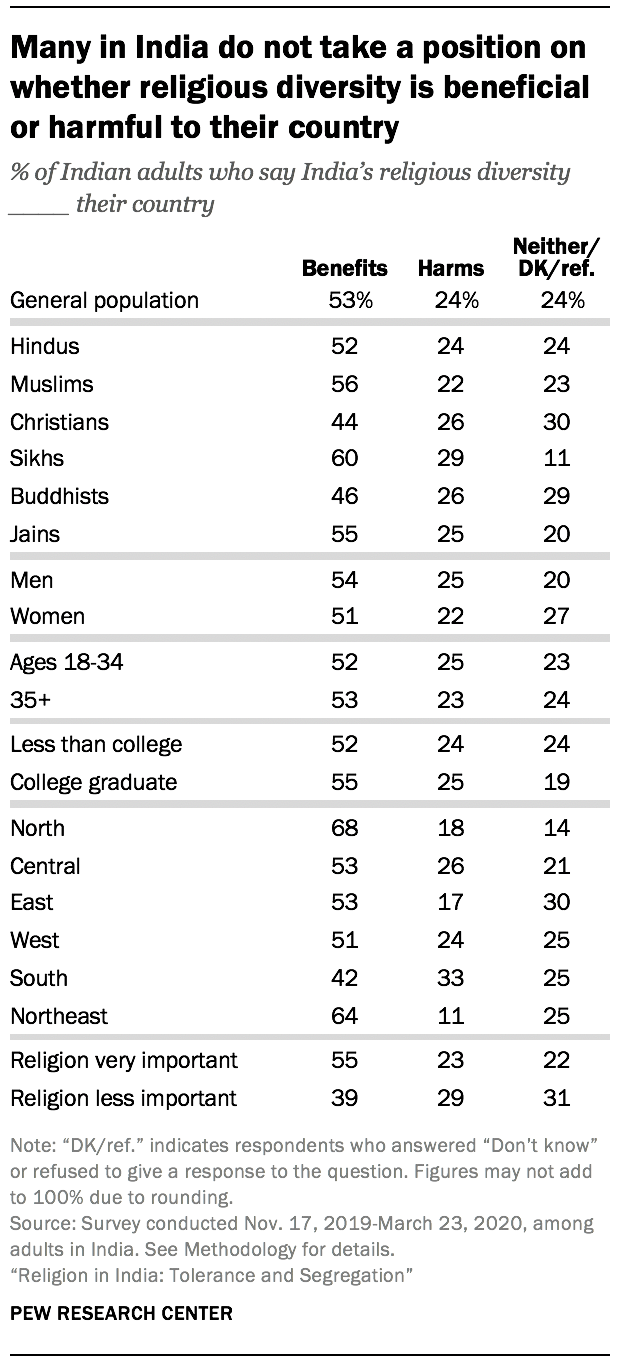
Indians tend to see this religious diversity as benefiting their country. Roughly half say diversity benefits India (53%), while about one-quarter say diversity harms the country (24%). Generally, Indians of different ages, educational backgrounds and regions of residence tend to agree that diversity benefits the country.
However, a sizable minority (24%) does not take a clear position on the question, saying that diversity “neither benefits nor harms the country,” that they don’t know, or declining to answer the question.
Majorities of Sikhs (60%), Muslims (56%) and Jains (55%) say religious diversity benefits India. Meanwhile, fewer than half of Buddhists (46%) and Christians (44%) take this position; about three-in-ten in both groups do not provide a clear answer either way.
The most religious Indians – that is, those who say religion is very important to their lives – are more likely than those who are less religious to say religious diversity is beneficial to the country (55% vs. 39%).
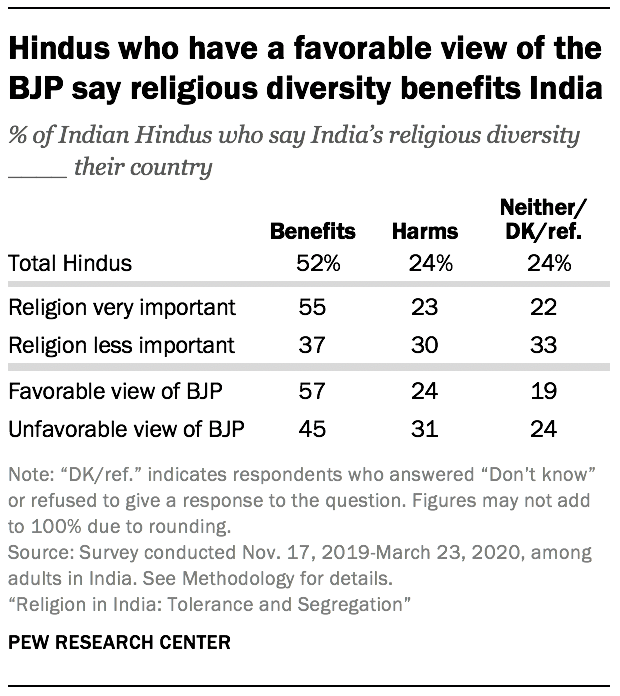
Among Hindus, a majority of those who have a favorable opinion of the ruling Bharatiya Janata Party (BJP) say religious diversity benefits the country (57%), compared with 45% among those who have an unfavorable opinion of the BJP.
Within the Indian population as a whole, attitudes about religious diversity also vary by region: Majorities in the North (68%) and Northeast (64%) think diversity benefits the country. The South is somewhat less positive: Southerners generally are less likely than those in other regions to say diversity benefits the country.
Hindus in the South are relatively unenthusiastic about the benefits of religious diversity: 42% say diversity benefits the country. And while roughly half of Southern Muslims (48%) say India’s diversity helps the country, in the North (68%) and Northeast (75%), higher shares of Muslims see India’s religious diversity as an asset.
Most Buddhists, Muslims and Christians see members of their own religion as very different from Hindus
Even though Indians tend to value their country’s religious diversity, India’s religious communities generally don’t see much in common with one another. Across religious groups, large shares say that, based on what they know, members of their religious group are “very different” from followers of other religions. In fact, only 36% of all Indian adults say their group has “a lot in common” with even one of the five other major groups mentioned in the survey; the remainder (64%) either say they are very different from, or do not give a definite answer about, all five other groups.
For example, majorities among Indian Buddhists (67%), Muslims (64%) and Christians (58%) say they are very different from Hindus. Jains and Sikhs, on the other hand, tend to take the view that they have a lot in common with Hindus – 66% of Jains and 52% of Sikhs say this, the only two cases in which majorities or pluralities of one group say they have “a lot” in common with another group.
Most people in India’s non-Muslim religious groups don’t see much in common between the Muslim community and their own. Most Hindus (66%) say their group is very different from Muslims, as do nearly nine-in-ten Buddhists (88%). Sikhs are the most likely to say they have a lot in common with Muslims – 36% of Sikhs say this. Still, the majority view among Sikhs is that they are very different from Muslims (55%).
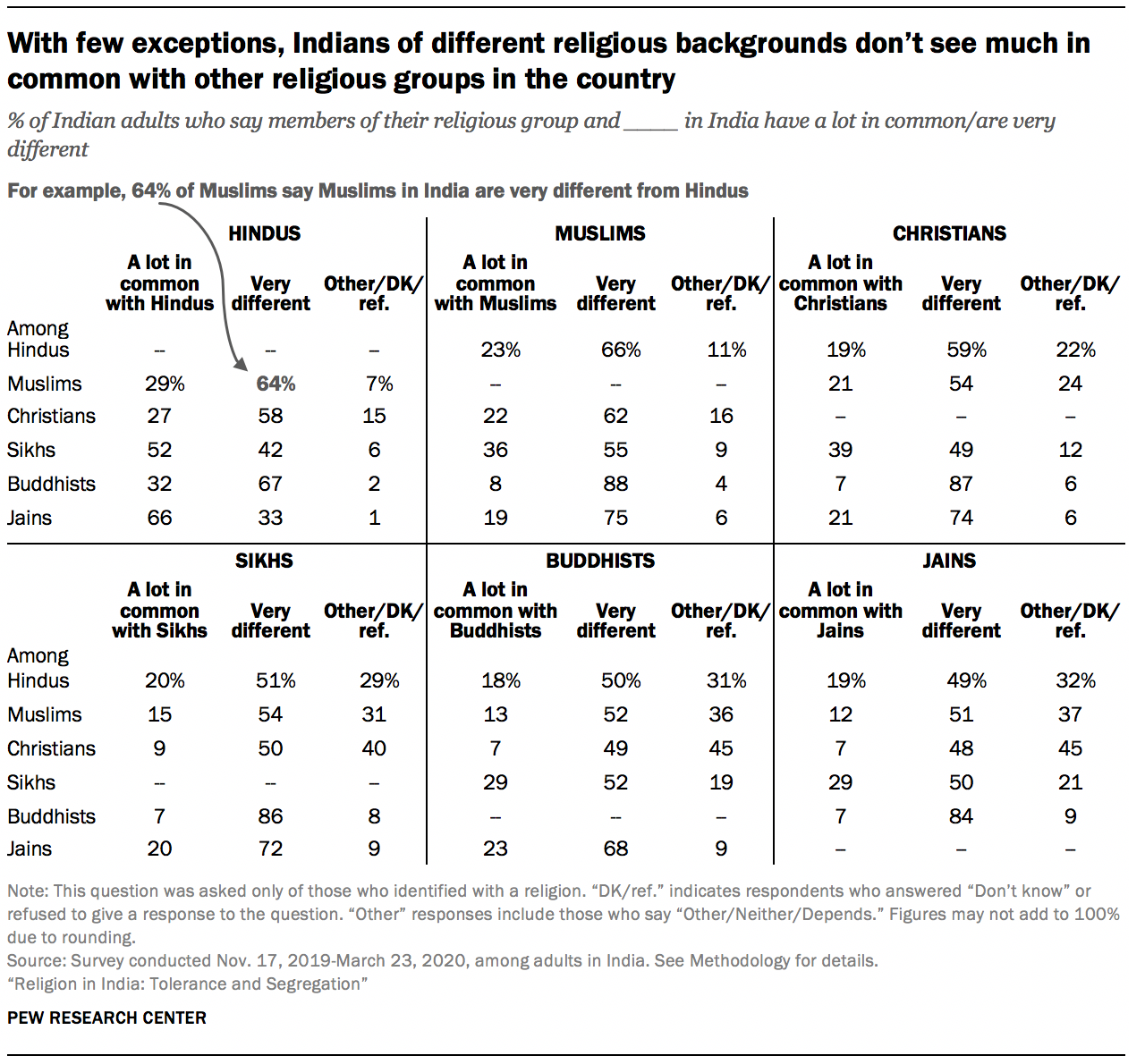
While many Sikhs see common ground with other groups, members of those groups generally are less likely to say they have a lot in common with Sikhs. For instance, 52% of Sikhs say they have a lot in common with Hindus, while just 20% of Hindus say the same about Sikhs. Members of some of these groups may be less familiar with the relatively small Sikh population that is also concentrated in the state of Punjab; about three-in-ten Hindus and Muslims and four-in-ten Christians say they “don’t know” or otherwise decline to answer the question about how much they have in common with Sikhs.
People in the North of India are more likely than those in other regions to say their religious group has a lot in common with other groups. This pattern holds true across multiple religious groups. People in the Western, Central and Northeastern regions, meanwhile, generally are less likely to see commonalities among religious groups.
Indians are highly knowledgeable about their own religion, less so about other religions
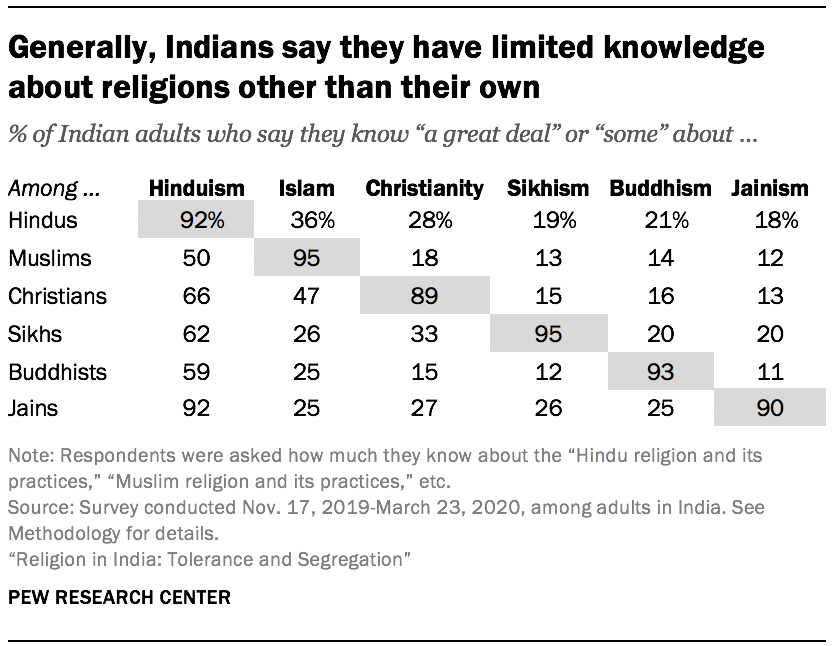
Considerably fewer people say they know a great deal – or even some – about other religions. For example, roughly a third of India’s Hindus (36%) say they know at least something about Islam, and even fewer say they know something about Christianity (28%). About one-in-five Hindus say they have at least some knowledge about Buddhism (21%), Sikhism (19%) or Jainism (18%), despite theological similarities between Hinduism and these three religions. Most Hindus say they know “not very much” or “nothing at all” about each of the other faiths.
Of course, the vast majority of Indians are Hindu, and it stands to reason that non-Hindus living in India would have at least some knowledge about Hinduism. Half of Muslims and most Jains (92%), Christians (66%), Sikhs (62%) and Buddhists (59%) say they know at least something about the Hindu religion and its practices.
Yet Christians, Sikhs, Jains, Buddhists and Muslims generally know less about one another’s religions. For example, just 26% of Sikhs say they know at least “some” about Islam, and only 13% of Muslims say they know something about the Sikh religion and its practices.
One exception is how much Christians know about Islam. Nearly half of Christians (47%) say they know either a lot or some about Islam. Far fewer Muslims (18%) say the same about Christianity.
More Muslims in the South of the country than elsewhere say they know about other religions. For example, about half of Muslims in the South (53%) say they have at least some knowledge of Christianity, compared with 18% of Muslims nationally. And a large majority of Southern Muslims (76%) say they know at least something about Hinduism, including (27%) who say they know a lot about the country’s majority religion. By comparison, half of Muslims nationally indicate they know at least something about Hinduism, and just 9% say they know a lot about the religion.
Among Hindus, those who are college educated are more likely to claim at least some knowledge about other religions. Hindus who live in the North of India are more likely than Hindus overall to say they know at least something about Sikhism (44% vs. 19% nationally), perhaps because many Sikhs are concentrated in the Northern state of Punjab. And Hindus from the South are much more likely than those elsewhere to say they have some knowledge of Islam (54% vs. 36% nationally) and Christianity (56% vs. 28% nationally).
Indians lean toward seeing truth in many religions
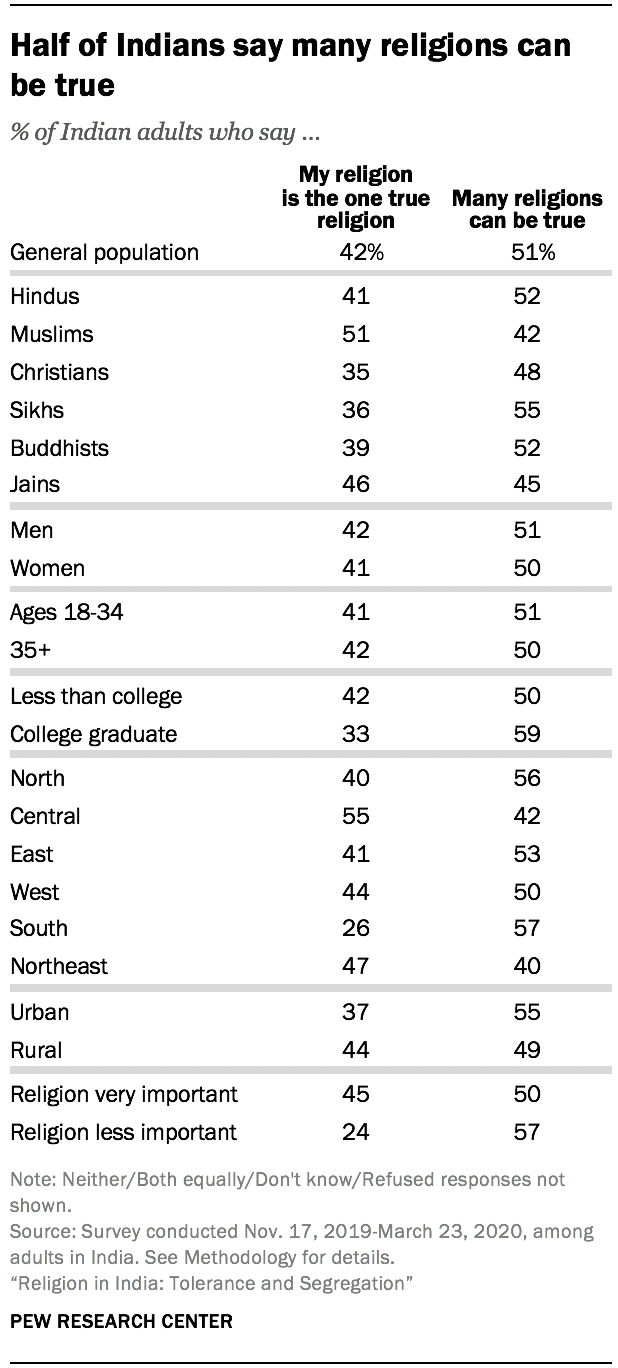
The predominant view among Hindus, Christians, Sikhs and Buddhists is that there are many true religions. Muslims have the largest share who take the position that theirs is the one true religion (51%). Jains are about evenly divided on this question.
Gender and age make little difference in whether people believe their religion is the only true one. There is, however, a link between education and views on this question: College-educated Indians are more likely than others to say many religions can be true (59% vs. 50%). Also, people living in urban areas of the country are slightly more inclined to take this position than rural Indians (55% vs. 49%).
Generally, Indians who are more religiously observant are much more likely to take the view that theirs is the one true religion. Among Indians who say religion is very important in their lives, 45% say only their religion is true, compared with a quarter (24%) of Indians who say religion is less important in their lives. This pattern holds among both Hindus and Muslims; for example, 53% of Muslims who say religion is very important in their lives see Islam as the one true religion, compared with 35% among those who consider religion less important.
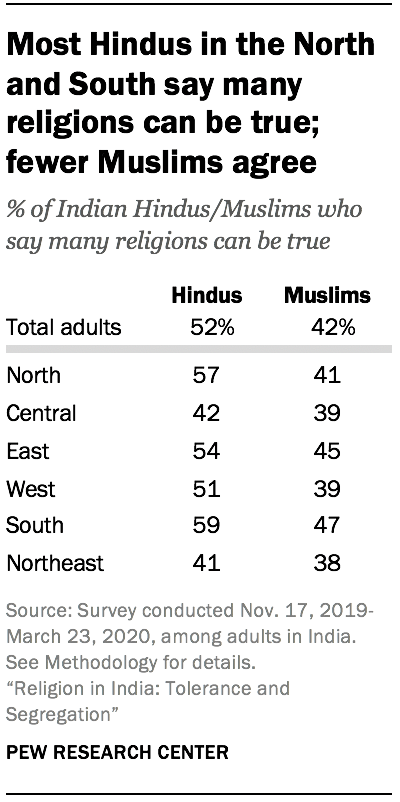
Regionally, majorities of Indian adults in the North, East and South say many religions can be true. By contrast, those in the Central region are generally more likely to say their religion is the one true faith (55%).
Among Hindus in the North, a majority (57%) say many religions can be true. But among Northern Muslims, about the same share take the opposite view: 58% say Islam is the one true religion.
Substantial shares of Buddhists, Sikhs say they have worshipped at religious venues other than their own
In an effort to understand whether Indians of various religious backgrounds mix religious practices, the survey asked people if they have ever prayed, meditated or performed a ritual in a house of worship other than the one associated with their own religion. For example, Sikhs were asked if they have ever prayed, meditated or performed a ritual at a mosque, church, Hindu temple, Buddhist stupa or Sufi shrine. (For more discussion of religious beliefs and practices that many Indians have in common, see Chapter 7 and Chapter 11 .)
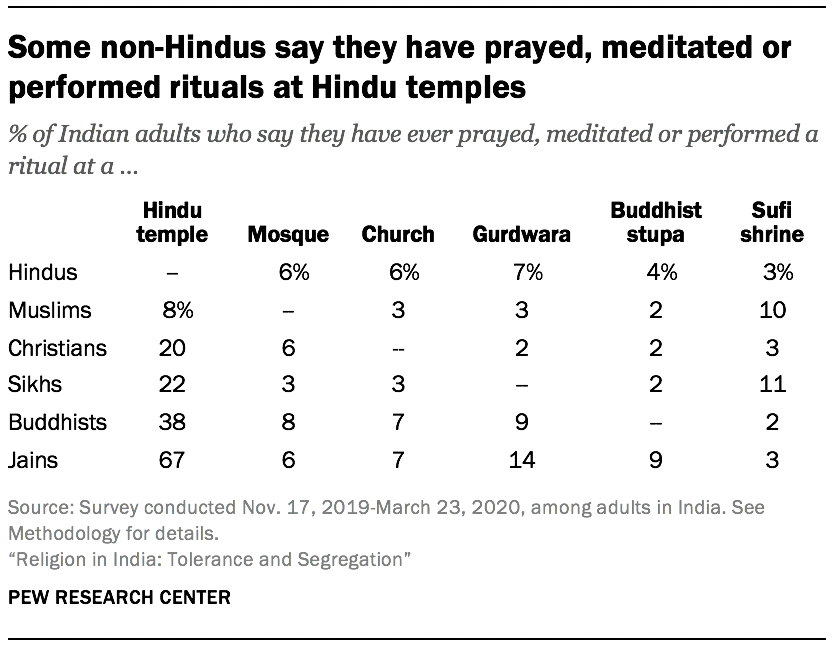
The distinction between Hindu and Jain temples is often ambiguous, so it stands to reason that a majority of Jains (67%) say they have worshipped at a Hindu temple. Some Jains (14%) also have prayed at a Sikh gurdwara.
About one-in-ten Sikhs (11%) and Muslims (10%) say they have prayed, meditated or performed a ritual at a Sufi shrine; Sufism tends to be most closely associated with a particular interpretation of Islam, although people of many faiths in India identify with Sufism (see Chapter 5 for details).
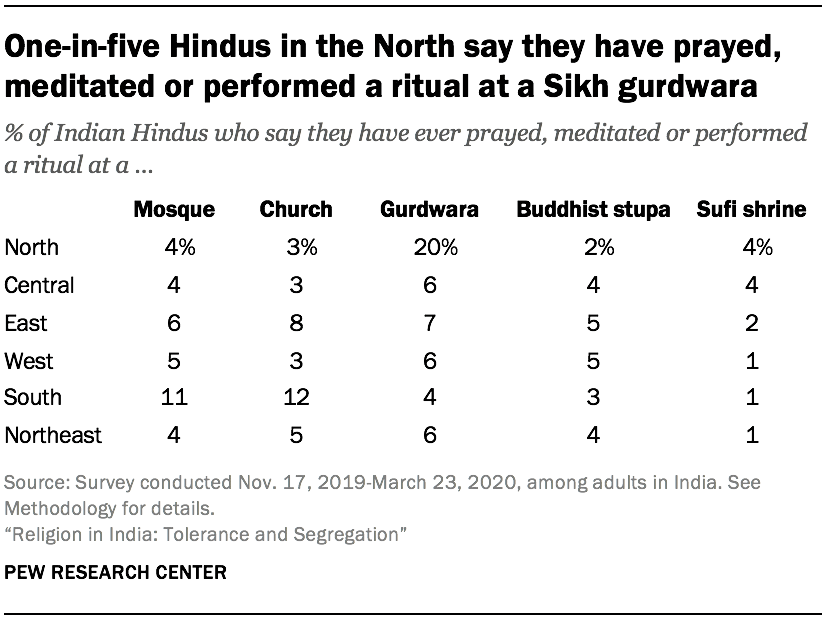
In the South, where many of India’s Christians are concentrated, about one-in-ten Hindus (12%) say they have prayed at a church, and roughly the same share (11%) say they have performed a ritual at a mosque.
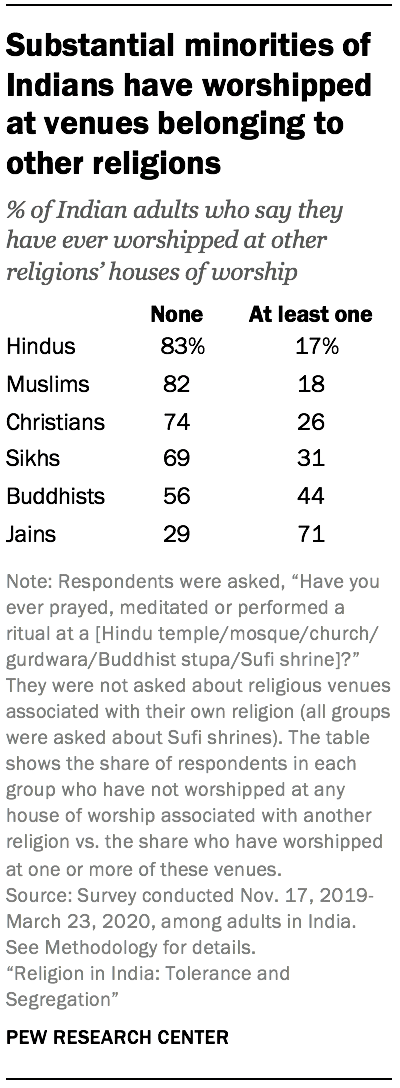
Among Muslims, 18% say they have prayed at a house of worship other than a mosque, including those who have worshipped at a Sufi shrine. (Sufi shrines are most closely associated with Islam, though there is also anti-Sufi sentiment among some Muslims in parts of the world.) Excluding Sufi shrines, one-in-ten Muslims in India have worshipped at a church, Hindu temple, Sikh gurdwara or Buddhist stupa.
Overall, men and college-educated Indians are slightly more likely to say they have prayed, meditated or performed a ritual at one or more venues associated with another religion. For example, 10% of college-educated Hindus have prayed at a church, compared with 6% of those who have less education.
One-in-five Muslims in India participate in celebrations of Diwali
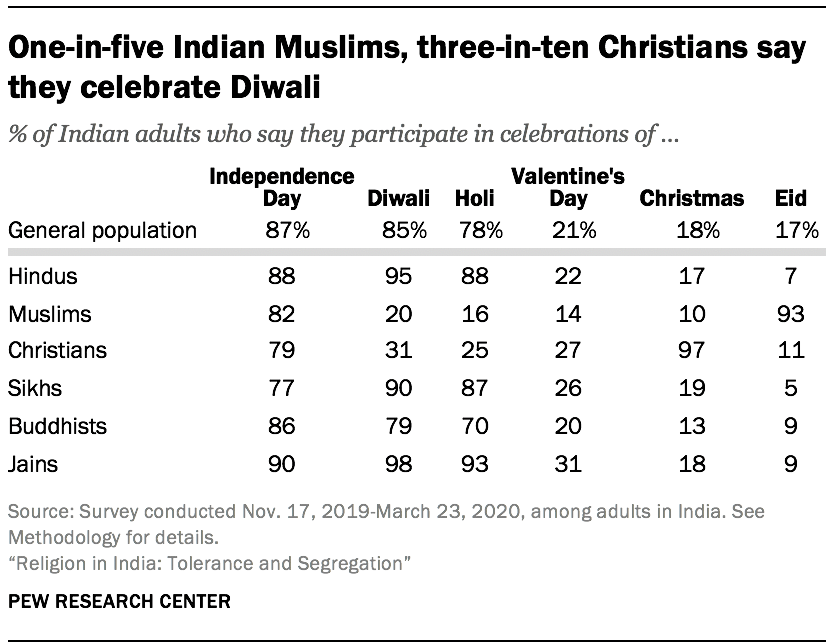
As expected, most people celebrate festivals associated with their own religious tradition. Near-universal shares of Hindus (95%), Sikhs (90%) and Jains (98%) say they celebrate Diwali, as do about eight-in-ten Buddhists (79%). Muslims overwhelmingly say they participate in celebrations of Eid (93%), and virtually all Christians (97%) celebrate Christmas. In addition, the vast majority of Indians (87%), regardless of their religious background, commemorate the day India declared its independence from British rule, celebrated on Aug. 15.
But many Indians also celebrate festivals that are not traditionally associated with their respective religions. For example, substantial shares of Muslims (20%) and Christians (31%) in India say they participate in Diwali celebrations. Also, notable shares of both those religious communities (16% of Muslims and 25% of Christians) say they participate in celebrating Holi, the spring festival of color that is observed by most Hindus, Sikhs, Buddhists and Jains.
Fewer Hindus (and other non-Muslims) celebrate the Muslim holiday of Eid. Among Hindus, 7% say they participate in celebrations of Eid, as do 11% of Christians. But celebrations of Christmas are relatively popular among non-Christians in India: Nearly one-in-five Hindus, Sikhs and Jains say they participate in Christmas festivities.
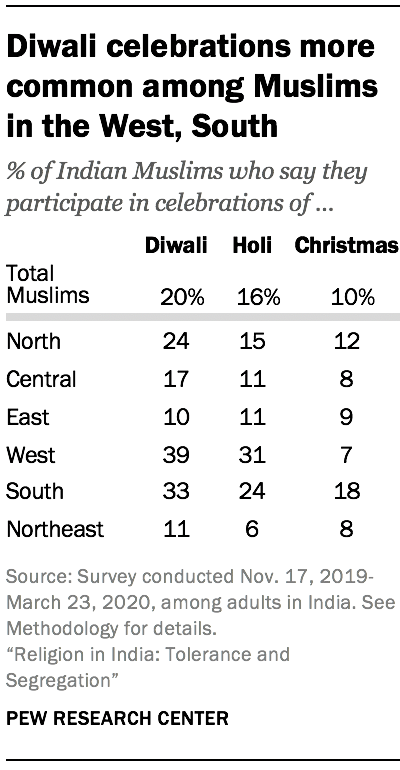
Muslims vary regionally when it comes to celebrating Diwali and Holi. Among Muslims in the North, nearly a quarter (24%) say they celebrate Diwali, and 15% participate in Holi festivities. In Western India, even larger shares of Muslims say they participate in Diwali (39%) and Holi (31%) celebrations.

Nationally, marking Valentine’s Day tends to be more popular among young adults (35% among those ages 18 to 25), those who have a college education (40%) and those who live in urban areas (27%). It also is more commonly celebrated by people who do not consider religion very important in their lives (27%, vs. 20% among those who see religion as very important).
Even though some Hindu groups have criticized Valentine’s Day as foreign to Indian culture and inappropriate for a socially conservative society, participation in the holiday is not politically divided. People who have a favorable opinion of the ruling party are no less likely than those who have an unfavorable view of the BJP to say they celebrate Valentine’s Day (21% and 20%, respectively).
- A national survey fielded by the Centre for the Study of Developing Societies in 2019 found that 21% of Indians either fully or somewhat agree with the statement “Only my religion is correct, not of anyone else,” while a majority of Indians (57%) somewhat or fully disagree with it. ↩
Sign up for our Religion newsletter
Sent weekly on Wednesday
Report Materials
Table of contents, india’s sex ratio at birth begins to normalize, how indians view gender roles in families and society, key facts about the religiously and demographically diverse states of india, religious composition of india, key findings about the religious composition of india, most popular.
About Pew Research Center Pew Research Center is a nonpartisan fact tank that informs the public about the issues, attitudes and trends shaping the world. It conducts public opinion polling, demographic research, media content analysis and other empirical social science research. Pew Research Center does not take policy positions. It is a subsidiary of The Pew Charitable Trusts .
TALK WITH SHIVI

Cultural Diversity in India Essay
Table of Contents
Essay on India’s Cultural Diversity
Introduction:.
India is a land of diversity, with a rich cultural heritage that is a product of its long and complex history. The country has undergone significant changes, with various cultural influences shaping its identity over the centuries. India’s cultural diversity is a reflection of the many religions, languages, customs, traditions, and beliefs that have contributed to the country’s unique identity and character.
Religions in India:
India is known for its religious diversity, with numerous religions and beliefs practiced throughout the country. Hinduism is the most widely practiced religion, followed by Islam, Christianity, Sikhism, Buddhism, Jainism, and Zoroastrianism. The country’s religious diversity is a testament to its long and complex history, with various religions and beliefs shaping the country’s cultural heritage over time.

Hinduism is one of the world’s oldest religions, and its roots can be traced back to the Indus Valley Civilization, which existed from 2600 BCE to 1900 BCE. The religion is characterized by a vast array of gods and goddesses, each representing different aspects of the universe. Hinduism also emphasizes the importance of karma, dharma, and reincarnation. Islam, on the other hand, was introduced to India in the 7th century and has since become the second-largest religion in the country. Christianity was brought to India by Portuguese traders in the 16th century, while Sikhism, Buddhism, Jainism, and Zoroastrianism all have their roots in India.
Languages in India:
India is home to a vast array of languages, with over 1,600 dialects spoken across the country. The most widely spoken language is Hindi, followed by Bengali, Telugu, Marathi, Tamil, and Urdu. Each language has its own unique history and cultural significance, contributing to the country’s rich linguistic diversity.
India’s linguistic diversity is a reflection of its complex social fabric and history. The various languages spoken in India have their roots in different regions and cultures, each contributing to the country’s diverse linguistic heritage. The Constitution of India recognizes 22 languages as official languages of the country, with Hindi and English being the primary languages used for official purposes.
Festivals in India:
India is known for its diverse culture and traditions, which are reflected in the many festivals celebrated throughout the country. These festivals showcase India’s rich heritage and provide an opportunity for people of all backgrounds to come together and celebrate. Each festival has its own unique history, significance, and traditions, and is celebrated with great enthusiasm and zeal. From the colorful Holi festival to the Diwali festival of lights, from the vibrant Durga Puja to the harvest festival of Baisakhi, India’s festivals are a testament to the country’s cultural diversity and unity. In this essay, we will explore some of the most popular festivals in India and their significance, highlighting how they contribute to India’s cultural identity and heritage.
Food in India:
Indian cuisine is renowned for its diverse and flavorful dishes, with each region of the country having its own unique culinary traditions. Indian food is characterized by its use of spices, herbs, and aromatic ingredients, with vegetarianism also playing a significant role in many parts of the country. Some of the most popular dishes in India include biryani, dosa, samosas , and butter chicken, among others.

Indian cuisine has been influenced by various factors, including geography, climate, religion, and culture. Each region of the country has its own unique culinary traditions, with distinct flavors and ingredients that reflect the local culture and environment. For example, the cuisine of North India is characterized by its rich and hearty dishes, while the cuisine of South India is known for its use of coconut and spices.
Art and Architecture in India:
India has a rich and vibrant cultural heritage when it comes to art and architecture, with a long history of artistic expression dating back to ancient times. Indian art is known for its intricate designs, vibrant colors, and attention to detail, with various art forms like painting, sculpture, and textiles playing a significant role in the country’s cultural heritage. India is also home to a vast array of architectural wonders, including ancient temples, forts, and palaces that showcase the country’s rich architectural traditions.
Evolution of India’s Cultural Diversity:
India’s cultural diversity has evolved over centuries, with various factors contributing to its unique identity and character. India’s geographical location played a significant role in shaping its cultural heritage, with its position on major trade routes attracting merchants and traders from different parts of the world. This led to the exchange of ideas, beliefs, and traditions, contributing to the country’s cultural diversity.
India’s cultural heritage has also been shaped by its long and complex history. The country has been ruled by various dynasties, each leaving their mark on the country’s cultural landscape. The Mughal Empire, for example, played a significant role in shaping India’s art and architecture, while the British Raj introduced new ideas, customs, and traditions to the country.
India’s cultural diversity has also been shaped by various religions and beliefs. Each religion and belief system has its own unique traditions and customs, contributing to the country’s rich cultural heritage. Hinduism, for example, has played a significant role in shaping India’s art, architecture, and literature, while Islam and Christianity have contributed to the country’s linguistic and culinary diversity.
Importance of India’s Cultural Diversity:
India’s cultural diversity is an essential aspect of its identity and character, contributing to the country’s rich cultural heritage. The various religions, languages, customs, traditions, and beliefs that make up India’s cultural diversity have played a significant role in shaping the country’s history and social fabric.
India’s cultural diversity is also a source of strength and resilience, contributing to the country’s economic, political, and social development. The country’s cultural diversity has enabled it to build bridges with different countries and cultures, facilitating trade, diplomacy, and cultural exchange.
Furthermore, India’s cultural diversity is a source of pride and identity for its people. It reflects the country’s long and complex history, showcasing its unique identity and character. India’s cultural diversity is also a source of inspiration for its artists, writers, musicians, and filmmakers, who draw on the country’s rich cultural heritage for their creative works.
Conclusion:
India’s cultural diversity is a testament to the country’s long and complex history, with various religions, languages, customs, traditions, and beliefs contributing to its unique identity and character. The country’s cultural diversity has evolved over centuries, shaped by its geographical location, history, and social fabric.
India’s cultural diversity is also a source of strength, resilience, and identity for its people. It has enabled the country to build bridges with different countries and cultures, facilitating trade, diplomacy, and cultural exchange. India’s cultural diversity is a source of pride and inspiration for its people, reflecting the country’s unique identity and character. As India continues to grow and develop, its cultural diversity will continue to play a significant role in shaping its future.
2 thoughts on “Cultural Diversity in India Essay”
- Pingback: Essay on Sadbhavana Diwas | Sadbhavana Diwas Essay
- Pingback: 10 Lines on Village for Students - TALK WITH SHIVI
Leave a Comment Cancel reply
Save my name, email, and website in this browser for the next time I comment.
Essay on Indian Culture for Students and Children
500+ words essay on indian culture.
India is a country that boasts of a rich culture. The culture of India refers to a collection of minor unique cultures. The culture of India comprises of clothing, festivals, languages, religions, music, dance, architecture, food, and art in India. Most noteworthy, Indian culture has been influenced by several foreign cultures throughout its history. Also, the history of India’s culture is several millennia old.
Components of Indian Culture
First of all, Indian origin religions are Hinduism, Buddhism, Jainism, and Sikhism . All of these religions are based on karma and dharma. Furthermore, these four are called as Indian religions. Indian religions are a major category of world religions along with Abrahamic religions.
Also, many foreign religions are present in India as well. These foreign religions include Abrahamic religions. The Abrahamic religions in India certainly are Judaism, Christianity, and Islam. Besides Abrahamic religions, Zoroastrianism and Bahá’í Faith are the other foreign religions which exist in India. Consequently, the presence of so many diverse religions has given rise to tolerance and secularism in Indian culture.
The Joint family system is the prevailing system of Indian culture . Most noteworthy, the family members consist of parents, children, children’s spouses, and offspring. All of these family members live together. Furthermore, the eldest male member is the head of the family.
Arranged marriages are the norm in Indian culture. Probably most Indians have their marriages planned by their parents. In almost all Indian marriages, the bride’s family gives dowry to bridegroom. Weddings are certainly festive occasions in Indian culture. There is involvement of striking decorations, clothing, music, dance, rituals in Indian weddings. Most noteworthy, the divorce rates in India are very low.
India celebrates a huge number of festivals. These festivals are very diverse due to multi-religious and multi-cultural Indian society. Indians greatly value festive occasions. Above all, the whole country joins in the celebrations irrespective of the differences.
Traditional Indian food, arts, music, sports, clothing, and architecture vary significantly across different regions. These components are influenced by various factors. Above all, these factors are geography, climate, culture, and rural/urban setting.
Get the huge list of more than 500 Essay Topics and Ideas
Perceptions of Indian Culture
Indian culture has been an inspiration to many writers. India is certainly a symbol of unity around the world. Indian culture is certainly very complex. Furthermore, the conception of Indian identity poses certain difficulties. However, despite this, a typical Indian culture does exist. The creation of this typical Indian culture results from some internal forces. Above all, these forces are a robust Constitution, universal adult franchise, secular policy , flexible federal structure, etc.
Indian culture is characterized by a strict social hierarchy. Furthermore, Indian children are taught their roles and place in society from an early age. Probably, many Indians believe that gods and spirits have a role in determining their life. Earlier, traditional Hindus were divided into polluting and non-polluting occupations. Now, this difference is declining.
Indian culture is certainly very diverse. Also, Indian children learn and assimilate in the differences. In recent decades, huge changes have taken place in Indian culture. Above all, these changes are female empowerment , westernization, a decline of superstition, higher literacy , improved education, etc.
To sum it up, the culture of India is one of the oldest cultures in the World. Above all, many Indians till stick to the traditional Indian culture in spite of rapid westernization. Indians have demonstrated strong unity irrespective of the diversity among them. Unity in Diversity is the ultimate mantra of Indian culture.
FAQs on Indian Culture
Q1 What are the Indian religions?
A1 Indian religions refer to a major category of religion. Most noteworthy, these religions have their origin in India. Furthermore, the major Indian religions are Hinduism, Buddhism, Jainism, and Sikhism.
Q2 What are changes that have taken place in Indian culture in recent decades?
A2 Certainly, many changes have taken place in Indian culture in recent decades. Above all, these changes are female empowerment, westernization, a decline of superstition, higher literacy, improved education, etc.
Customize your course in 30 seconds
Which class are you in.

- Travelling Essay
- Picnic Essay
- Our Country Essay
- My Parents Essay
- Essay on Favourite Personality
- Essay on Memorable Day of My Life
- Essay on Knowledge is Power
- Essay on Gurpurab
- Essay on My Favourite Season
- Essay on Types of Sports
Leave a Reply Cancel reply
Your email address will not be published. Required fields are marked *
Download the App


Cultural Diversity in India Essay, Indian Diversity Essay
Are you also looking for “Cultural Diversity in India Essay? If yes , then you have fallen on the world’s best website essayduniya.com. If you are searching Diversity in India essay 200 words, Article on cultural diversity in India, Cultural diversity essay, Cultural diversity in India UPSC, Short essay on cultural diversity in India, Cultural diversity in India essay pdf , India nation of diversity Essay, Indian diversity Essay, Cultural diversity in India PDF, Project on cultural diversity in India then your wait ends here.
Cultural Diversity in India Essay 200 Words
India, with a population of 1.38 billion people, has a rich cultural diversity. Because of population diversity, Indian culture is quite diverse. It is a mixture of numerous ethnicities from various religions, each with its own culture and traditions. Indian culture is one of the oldest in the world . Even throughout the Bronze Age, India had an urban civilization. The Indus Valley Civilization, also known as the Harappan Civilization, existed between 3300 BC and 1300 BC . India is one of the world’s most religious countries, with huge and active Hindu (80.45%) , Muslim (13.43%), Christian (2 . 34%), Sikh (1 . 86%), and other communities.
Unlike in the West, where religion is considered “private , ” Indians choose to make their religions open. Each state in the country has different communities that coexist while retaining and supporting its own distinct culture and traditions . From Delhi, India’s capital, to Tamil Nadu , the country’s southernmost state, the country is endowed with breathtaking natural beauty. The country also has various historical monuments that contribute to India’s diverse heritage . The Indian culture refers to the way of life of the Indian people. There is almost no other culture in the world that is as diverse and distinct as India’s.

Cultural Diversity in India Essay 300 Words
India is rich in traditions and has a distinct culture in terms of festivals , cuisines, dialects, dress, and so on. Indian heritage and culture have extended not only in India but also throughout Asia and many European countries. The nation is divided into twenty-nine states and seven union territories and is located on the Asian continent, bounded by the Arabian Sea, the Indian Ocean, and the Bay of Bengal. India’s neighbors are Pakistan, China, Bangladesh, Myanmar , Bhutan, and Nepal. Despite numerous foreign invasions, a vast synthesis of cultures, faiths, and languages of people from various castes and communities has maintained its unity and coherence. It is the mixture of numerous magnificent cultures that defines India . The diversity of Indian cultures is what differentiates and beautifies India. The landscapes of India are tremendously diverse, ranging from snow-capped mountain ranges to deserts, plains, hills, and plateaus.
India is a tremendously diverse country , and so is Indian architecture . The architecture of India ranges from prehistoric caves to modern skyscrapers. As India grows, its architecture continues to diversify by returning to its traditions while adhering to modern trends. As India develops , its architecture continues to expand by returning to traditions while sticking to current trends. Throughout the country, India celebrates numerous festivals such as Diwali , Holi, Eid, and Christmas. Which, once again, is observed in many places of the world. India is a multi-cuisine country . The majority of the cuisines are South Indian, North Indian, and seafood.
India is rich in various forms of art, dance, and theatre . Each state in India has its own folk dance culture, which is experienced at most festivals or as a welcome dance to visitors that enter the state or country. Most foreign nationals visit India to experience these traditions and desire to live, eat, and dance in accordance with Indian cultures, traditions, and customs.
Cultural Diversity in India Essay 500 Words
When we look at the history of India, we see that people from all over the world traveled to India and later became united by the Indian culture. As a result, several civilizations became mixed together. This is the true reason behind India’s cultural variety. Despite many foreign invasions, a vast synthesis of cultures, faiths, and languages of people from various castes and communities has maintained its unity and togetherness. This diversity has enriched the social lives of all Indians. Languages, festivals, religions, delicacies, dressing styles, and many more obvious facts help to explain India’s cultural variety. Each state in India is home to many communities that live in harmony with one another while retaining and sustaining their own distinct culture and traditions.
Let us know about Indian culture and its significance in detail.
Language Diversity
India possesses around 121 languages (22 languages and 99 languages not included in the Eighth Schedule) and over 19,500 dialects. Most of these languages are spoken by a small number of people, or they are restricted to specific regions, states , or places.
Clothing Diversity
India’s enormous and endless variety of traditional clothing is full of attractive appearances. Fabrics, weaving procedures, embellishments , styles, and various accessories are made in numerous states around the country. Each element included in the cloth tells a tale about craftsmanship, culture, or legacy. The country is a heritage-style center. In addition to western apparel , Indians have their own cultural attire such as dhoti, kurta, sari, sherwani, turban, and so on.
Cultural variation
Cultural patterns reflect geographic differences. Because of demographic diversity, Indian culture is dramatically different, as it is a combination of diverse cultures . Different Religions, castes, and regions all over the country have their own traditions and cultures . As a result, there is variety in art, architecture, dance styles, theatre forms, and music.
Religious Diversity
India is a multi-religious country. Aside from tribal communities, many of whom still practice animism and magic, the Indian population is made up of Hindus (82.41%), Muslims (11.6%), Christians (2.32%), Sikhs (1.99%), Buddhists (0 . 77%), and Jains (0.41%) . Hindus are split into numerous sects, including Vaishnavas, Shaivites, Shaktas, and Smartas. Similarly, Muslims are classified into sects such as Shias, Sunnis, Ahmadis, and others.
Food Diversity
Indian cuisine is among the most flavorful and tasty in the world. There is no flavor homogeneity between North and South, East and West, but rather an amazing diversity of flavors . India’s food diversity is one of its assets. Indian cuisine encompasses so much that it is necessary to cover more than just “Indian cuisine.” Each region has its own culinary qualities and a variety of traditional cuisines. Each region has its own cuisine, not only at the regional but also at the provincial level.
India, the world’s seventh-largest country, has established a unique and distinct position among the world’s countries. India is one of the most diverse countries on the planet. From the clothing worn by individuals of various ethnicities to the languages spoken and even the eating preferences, the country displays its diversity and unique heritage.
Do tell us in the comment box how you like “ Cultural Diversity in India Essay ”? Next, on which topic do you want a speech or an essay, do tell us by commenting! We are waiting for your comments…!
Environmental Pollution Essay Save the environment for future generations Essay Winter Season Essay My Start up Dream Essay My Start up Dream Essay Importance of Education Essay Srinivasa Ramanujan essay Essay on Future Educational Challenges Know Your Freedom Fighters Essay Essay on 5G Technology in English
Leave a Comment Cancel reply
Save my name, email, and website in this browser for the next time I comment.
- Entertainment
- Environment
- Information Science and Technology
- Social Issues
Home Essay Samples Sociology Cultural Diversity
The Cultural History and Diversity of India
*minimum deadline
Cite this Essay
To export a reference to this article please select a referencing style below

- Sexual Orientation
- Deviant Behavior
- Collaboration
Related Essays
Need writing help?
You can always rely on us no matter what type of paper you need
*No hidden charges
100% Unique Essays
Absolutely Confidential
Money Back Guarantee
By clicking “Send Essay”, you agree to our Terms of service and Privacy statement. We will occasionally send you account related emails
You can also get a UNIQUE essay on this or any other topic
Thank you! We’ll contact you as soon as possible.

25,000+ students realised their study abroad dream with us. Take the first step today
Meet top uk universities from the comfort of your home, here’s your new year gift, one app for all your, study abroad needs, start your journey, track your progress, grow with the community and so much more.

Verification Code
An OTP has been sent to your registered mobile no. Please verify

Thanks for your comment !
Our team will review it before it's shown to our readers.

- School Education /
Essay on Indian Culture in 500 Words
- Updated on
- Dec 5, 2023

Did you know that Indian culture is one of the oldest and richest cultures in the world? Mark Twain once said, ‘India is the one land that all men desire to see, and having seen once, even a glimpse, would not give that glimpse for all the shows of all the rest of the globe combined.’ Indian culture is known for its rich beauty, traditional values, ethics, and social norms.
Also Read: English Essay Topics
Also Read: How to Write an Essay in English
Also Read: Speech on Republic Day for Class 12th
Check out all the latest updates related to all board exams 2024
‘We should proudly follow our cultural and traditional values, as they connect us to our age-old customs and what our culture means to us. India’s ethno-linguistically diverse culture has always been successful in catching global attention. Popular festivals like Diwali, Holi, Navratri, etc. are not only celebrated in India but also in other parts of the world.’
Also Read: Essay on Festivals
Why is Indian Culture Famous?
India’s rich and diverse culture has always attracted people from different parts of the world. A series of factors are responsible for Indian culture’s popularity, which include;
- Cultural diversity all over the country.
- Variety of religious and spiritual practices.
- Connections with the ancient Indus Valley Civilization, which is one of the oldest civilizations.
- Concepts like yoga and meditation, which gained popularity all over the world.
- Tradition art practices such as classical dance forms like Odissi, Bharatnatyam, Kuchipudi, etc.
- Traditional art forms like Tanjore and Madhubani paintings have gained global attention.
- Our vibrant and colorful festivals like Diwali, Holi, Eid, etc. are celebrated in not just India but in other countries as well.
- Our flavourful dishes and curries like roti sabzi, dal chawal, puri halwa, samosa, biryani, mithaiya, etc. are now sold all over the world.
Also Read: Essay on Health and Fitness
Interesting Facts About Indian Culture?
There are dozens of interesting facts about Indian culture, starting from ancient civilizations to modern times.
- One of the oldest cities in the world, Varanasi, was named the Tourism and Cultural Capital for the year 2022-23 by the Shanghai Cooperation Organization (SCO).
- One of the seven wonders of the world, the Taj Mahal, is located in India, which attracts millions of tourists every year.
- Zero (0) and decimal systems, used in mathematics, were invented in India. The modern numeral system is based on Indian numerical notations. (0,1,2,3, etc.)
- India is home to the world’s oldest holistic healing system; Ayurveda.
- The world’s longest epic, the Mahabharata, is based in India. This legend consists of over 1 lakh couplets (shlokas).
Also Read: Essay on Money
Things We Can Learn from Our Culture
Our culture connects us to our age-old belief system and social norms. We are born with our cultural beliefs, values, and practices. Our culture teaches us to:
- Understand why people do things the way they want to.
- Respecting everyone around us, especially our elders.
- Emphasize the relationship between family and bloodline.
- Respecting other people’s culture and traditions.
- Reflecting on adaptability to new systems and values.
- Connects us to our roots and gives us an identity.
- Encourages the preservation of our traditional and historical knowledge.
- Emphasizes generosity and hospitality towards our guests and neighbors.
- It focuses on creating a sense of belonging in a community and mutual support.
Also Read: Essay on Generation Gap
Paragraph on Indian Culture
Related Articles
Ans: Indian culture is one of the most oldest and popular cultures in the world. Our culture is known for its rich diversity, traditional values, ethics, and social norms. We should proudly follow our cultural and traditional values, as they connect us to our age-old customs and what our culture means to us. India’s ethno-linguistically diverse culture has always been successful in catching global attention. Popular festivals like Diwali, Holi, Navratri, etc. are not only celebrated in India but also in other parts of the world.
Ans: Indian culture is one of the oldest cultures in the world; Zero (0) and decimal systems were first used in Indian culture; Indian culture was the first one to follow the practice of Ayurveda, one of the oldest healing systems; world’s oldest legends, the Ramayana and Mahabharata, were recorded in India; and the name India is derived from a Greek word ‘Indica.’
Ans: India was ruled by various Muslim dynasties during the Medival period. They gave this land the name Hindustan, which is derived from the Persian word Hindu from the Sanskrit word Sindhu.
For more information on such interesting topics for your school, visit our essay writing page and make sure to follow Leverage Edu .
Shiva Tyagi
With an experience of over a year, I've developed a passion for writing blogs on wide range of topics. I am mostly inspired from topics related to social and environmental fields, where you come up with a positive outcome.
Leave a Reply Cancel reply
Save my name, email, and website in this browser for the next time I comment.
Contact no. *

Connect With Us

25,000+ students realised their study abroad dream with us. Take the first step today.

Resend OTP in

Need help with?
Study abroad.
UK, Canada, US & More
IELTS, GRE, GMAT & More
Scholarship, Loans & Forex
Country Preference
New Zealand
Which English test are you planning to take?
Which academic test are you planning to take.
Not Sure yet
When are you planning to take the exam?
Already booked my exam slot
Within 2 Months
Want to learn about the test
Which Degree do you wish to pursue?
When do you want to start studying abroad.
January 2024
September 2024
What is your budget to study abroad?

How would you describe this article ?
Please rate this article
We would like to hear more.
Have something on your mind?

Make your study abroad dream a reality in January 2022 with
India's Biggest Virtual University Fair

Essex Direct Admission Day
Why attend .

Don't Miss Out

IMAGES
VIDEO
COMMENTS
500 Words Essay on Cultural Diversity in India Introduction to Cultural Diversity in India. India, often hailed as the epitome of cultural diversity, is a country where myriad cultures, religions, languages, and traditions coexist in harmony. This cultural diversity is the cornerstone of India's pluralistic society and has shaped its history ...
500 Words Essay On Diversity In India. India is a land of unique and diverse cultures, religions, languages, and customs. The concept of 'unity in diversity' is a cornerstone of India's culture and identity, and is something that should be celebrated and embraced.
Indian religions have influenced and shaped the Indian culture. Diversity in Indian Customs and Tradition Photo by Raj Rana on Unsplash. The vast differences in the customs, traditional beliefs and rituals can be witnessed if one analyses the differences in the culture prevalent in the northern and southern part of India.
In conclusion, the cultural diversity of India is not a mere assortment of traditions; it is a living, breathing testament to the unity that can arise from embracing differences. From the languages spoken to the food savored, from the houses inhabited to the games played, and from the arts cherished to the monuments revered, India's cultural ...
India - A Land Of Diversity Essay. India is a kaleidoscope of cultures that includes umpteen variations in food, clothing, language, music and religious beliefs. This colourful spread has been shaped by the long history and unique geography of this land. Though cut off from the world by three oceans and the highest chain of mountains, this ...
Due to demographic diversity, Indian culture is extremely diverse and is a fusion of many other cultures. Every region, caste, and religion has its unique traditions and culture. As a result, there are variations in music, dance, theatre, and architecture.
In times of global divisiveness, India's composite culture stands tall as a testament to the strength and beauty of unity in diversity. Why Sociology for Success in CSE. To master these intricacies and fare well in the Sociology Optional Syllabus, aspiring sociologists might benefit from guidance by the Best Sociology Optional Teacher and ...
Evidently, cultural diversity has been a great beneficial factor to enriching the country both socially and economically. Culture is also expressed in art, namely, music, dance, poetry, drama, and painting. Art has led to the rise of pop culture amidst the cultural diversity in India accompanied by festivals that exhibit enthusiasm, color ...
India is a country with a rich cultural heritage, and its people are known for their diversity. Multi -. culturalism in India refers to the coexistence of diver se cultures and ethnic groups ...
2. Diversity and pluralism. Indians are much more likely to view their country's religious diversity as an asset than as a liability. About half of Indians (53%) say religious diversity benefits the country, while 24% say it is harmful. The remainder (24%) don't take a position either way.
Essay on India's Cultural Diversity Introduction: India is a land of diversity, with a rich cultural heritage that is a product of its long and complex history. The country has undergone significant changes, with various cultural influences shaping its identity over the centuries. India's cultural diversity is a reflection of the many ...
500+ Words Essay on Indian Culture. India is a country that boasts of a rich culture. The culture of India refers to a collection of minor unique cultures. The culture of India comprises of clothing, festivals, languages, religions, music, dance, architecture, food, and art in India. Most noteworthy, Indian culture has been influenced by ...
Cultural Diversity in India Essay 200 Words. India, with a population of 1.38 billion people, has a rich cultural diversity. Because of population diversity, Indian culture is quite diverse. It is a mixture of numerous ethnicities from various religions, each with its own culture and traditions. Indian culture is one of the oldest in the world.
Indian cultural history has been enriched by customs, traditions and rituals brought by invaders and immigrants. Many Indian customs, cultural practices and languages are examples of this mixture through the centuries. It is in India that many religions, such as Hinduism, Buddhism and Sikhism, have been born which have influenced not only this ...
Paragraph on Indian Culture. Indian culture is one of the oldest, most diverse, and richest cultures in the world because of several factors. Our welcoming attitude towards everyone is encouraged all over the world. There is diversity in every aspect of our culture, from religious practices to festivals, foods, and traditional art forms.
Cultural Diversity, even under such grave circumstances where a large part of the world is still devoured by Covid 19. by diversity. Secularism in India means the equality of treatment by the State for all religions. Religion has played an essential part in India's culture throughout India's history. The law
Abstract. Culture, in a society, evolves over long period of time when people interact with the elements of nature and social norms created by them. It also gets enriched when people of diverse social background live and interact with each other. Culture includes both the tangible (material) and non-tangible (non-material) elements.
Indian Culture Essay (100 words) ... each festival is a vivid spectacle of India's religious diversity and cultural richness. Linguistic Diversity. Language, the bedrock of culture, is exceptionally diverse in India, with more than 1,600 dialects and 22 officially recognized languages. Each language, poetic Urdu, melodious Tamil, or robust ...